
Bahrain BD 1.50 Kuwait KD 1.50 Oman OR 1.50, Saudi Arabia SR 12.00 UAE DH 10.00 UK £ 3.00, US $ 3.00 VOLUME 21 ISSUE 8 AUGUST 2023 21 YEARS Rs. 50


www.seasonalmagazine.com
Managing Editor
Jason D Pavorattikaran
Editor
John Antony Director (Finance)
Ceena
Associate Editor
Carl Jaison
Senior Editorial Coordinator Jacob Deva
Senior Correspondent
Bina Menon
Creative Visualizer
Bijohns Varghese
Photographer
Anish Aloysious Office Assistant Alby CG
Correspondents
Bombay: Rashmi Prakash
Delhi: Anurag Dixit Director (Technical)

John Antony
Publisher
Jason D Pavorattikaran
Editorial & Business Office
Cochin: 36/1924 E, Kaloor-Kadavanthra Road, Near IGNOU, Kaloor, Cochin-17.
Ph:0484- 2345876, 2534377, 2340080 Mob. 09947141362
Delhi: H.No: P-108, Uppal Southend, Sector 48, Sohna Road, Gurgaon, Haryana – 122018 Ph: 9891771857|099471 41362
Mumbai: 202, Woodland Heights Building, St. Martins Road, Bandra West, Mumbai400 050 Mob: 919947141362
Bangalore: House No: 493, Block 3 3rd Main, HBR Layout, Bangalore-4209731984836, Email:skmagazine@gmail.com www.seasonalmagazine.com
UK Office: “CRONAN”, Boundaries Road Feltham, Middlesex, UK TW13 5DR Ph: 020 8890 0045, Mob: 00447947181950 Email: petecarlsons@gmail.com

Reg No: KERENG/2002/6803
WHY IS THE INDIAN CAPITAL MARKET BOOMING?

Sensex is down over 800 points in a single day while penning this, but almost no one expects this to be the start of a much feared 10% correction in the Indian stock market. With Nifty eyeing the psychological success mark of 20,000, the chances of this being the start of a 10% steep correction is indeed low.
The first reason why the Indian capital market is continuing to boom is its deep coupling with the global markets, especially the US stock market. With S&P, Dow Jones and Nasdaq all eyeing to retake their earlier highs soon, Indian markets are more likely to follow suit rather than move in a contrasting way.
Secondly, the fear of an imminent recession in the US is slowly but surely dying down. While the later half of 2022 saw almost all experts predicting a sure shot recession in 2023, due to the US Federal Reserve’s over ambitious war on inflation and rate hikes, now the chances for the US entering a recession has turned slim, to less than 20%.
Not that anyone expected the Indian economy to follow the global pattern and enter a recession of its own, even if the US had slipped into a recession in 2023. But still, the chances of the
Subscriptions Available on iPhone/iPad & Android All health related articles are for first information purposes only. Always consult your doctor before taking any decison affecting your health.
MAGAZINE
Seasonal
Printed & Published by Jaison D on behalf of PeteCarlson Solutions Pvt. Ltd. at Cochin. Printed at Rathna Offset Printers, Chennai-14. All Rights Reserved by PeteCarlson Solutions Pvt. Ltd. No part of this publication may be reproduced by any means, including electronic, without the prior written permission of the publisher. MEMBER SEASONAL MAGAZINE EDITORIAL
Indian economy getting hurt in the short to medium term was real if the US economy had turned recessionary in this calendar year.
Yet another factor favouring the Indian economy and its capital market is the deep slowdown in China due to an over enthusiastic zero Covid policy that China had adopted post the pandemic. Global manufacturing giants and their supply chainsranging from electronics to chemicals to pharmafinally understood the folly of relying on a single nation, and that too an undemocratic and autocratic nation, and India has been a natural beneficiary of this move.
Even with all these favourable factors aiding the Indian economy, one of the biggest reasons behind the newfound strength in the Indian stock market is something totally unconnected, which has been an important policy change with regard to how public savings like in EPFO and NPS are invested. While the equity market was kind of untouchable for these huge funds in earlier periods, nowadays a significant portion of these funds are getting invested in the equity market. Some estimates show that around Rs. 18,000 crore worth of equities are being bought by these funds every month.
This had an interesting impact during the last round of significant pullout by foreign portfolio investors (FPIs) from the Indian market. Driven by the risk-

off trade possible by switching to US based fixed income instruments, FPIs had fled the Indian market during the fourth quarter of last fiscal, hoping to return when the trade risk became better.
But to their utter dismay, they had to return earlier than they had planned, when they saw the Indian market not correcting as steeply as per their expectations, and even starting to boom by the beginning of this fiscal. In earlier periods, this wouldn’t have happened, and is said to be a direct effect of this sustained buys using EPFO and NPS funds.
This is not to say that such buying is not without its own risks. For one, these funds, for ensuring transparency, are relying heavily on investing in only passively managed index funds, like the ones tracking Nifty 50 stocks, and this can result in a skewed market, if it hasn’t happened already. This can result in India’s largest listed companies getting larger and larger in valuations, even when their underlying financials are not warranting such inflows. Even more seriously, it can deter fund flows to midcaps and smallcaps that may be thirsting for better valuations to leverage better and grow faster. But for now, it is a strength that is playing to India’s advantage.
John Antony
SEASONAL MAGAZINE
CONTENTS
WHEN RATAN TATA HANDHOLDS
BALANCING INDUSTRIAL & SOCIAL GROWTH PERFECTLY IN HIS THIRD YEAR AS CM
Under Chief Minister MK Stalin’s visionary leadership that entered its third year recently, Tamil Nadu is forging ahead in sectors where it is aszy a leader, including renewable energy, electric vehicles, electronics manufacturing and automobiles, even while it is excelling in

A STATE AND ITS LEADER WITH UNIQUE PRIORITIES
Kerala has never been among India’s most industrialised states, and it may never emerge in such lists too, but that is because Kerala’s priorities have always been different. No one exemplifies this unique set of priorities as much as its
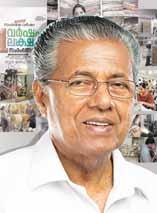
A LEADER AND A STATE THAT DID THE IMPOSSIBLE

Chandrashekar Rao rarely takes no for an answer from anyone. It was that trait that led KCR - as he is endearingly called - to achieve the impossible for the people of Telangana 9 years back. A sixty year old struggle to have statehood, that was long dead due to seemingly insurmountable obstacles, was single handedly resurrected by this people of the masses during a period of less than 15 years, and the

How Ratan Tata helped this 21-year-old man build a Rs 500 crore company. The Mumbai-based startup has the backing of legendary industrialist Ratan Tata who was impressed by the company’s innovative model.

BREAKFAST IS IMPORTANT, BUT YOU AREN’T HUNGRY!
Never hungry in the morning? Here’s what your lack of appetite is telling you.
PLAYING TO ITS OWN STRENGTHS
There was a time when everyone wrote off Kochi’s original Central Business District of MG Road and together with it, its famed shops like the textile major Seematti. Such was the new mega mall projects getting launched in the new hotspot of Edappally. But no one hadn’t counted on the resolve of its CEO & Chief Designer, Beena Kannan who has single-handedly expanded and modernised not only her textile mall into a sprawling 5 lakh square feet fashion venue, but transformed the entire north end of MG Road
WHAT IS THE BUZZ AROUND ANTI DOPAMINE PARENTING?


Could this be a way to curb tantrums? Parents Are Trying ‘Anti-Dopamine Parenting’. Here’s What That Means.

KIDS DESERVE TO TAKE UP SPACE TOO
Last summer, my husband and I drove with our 4-year-old and 2year-old to his hometown on the east coast of Canada. We were there to bury his parents, a memorial that had been a long time in the making because of the pandemic. It was a heavy, sometimes magical time that, after a few weeks, took its toll.
PROTECT YOURSELF AGAINST 10 COMMON TRAVEL SCAMS
Tips on how to avoid swindles, plus a sampling of destinations where tourists are at risk.

SEASONAL MAGAZINE
HOW SAFE ARE OUR UNIVERSITIES COLLEGES AND SCHOOLS FOR OUR CHILDREN?



Since 2017, self-harm by students has been on the rise, and by 2021 itself, India has been losing around 13,000 students per year to suicide, which translates to over 35 student suicides a day. And in the last two years, these numbers have most probably spiked, going by the frequent reports coming from all over the country. In the run-up and aftermath of this year's NEET exam itself, several suicides have been reported in the so-called entrance hubs like Kota, with Allen Institute alone witnessing five suicides. No
HEALTHCARE LOOKS BEYOND BMI
BMI has meant slapping an “overweight” or “obese” label on some people who are perfectly healthy, while overlooking others whose BMI is considered normal, but could use better guidance on exercising or eating healthy foods

DOES YOUR EXPECTATIONS FORM THE WAY YOU EXPERIENCE THE WORLD?
Yes, says Andy Clark, a philosopher of mind at the University of Sussex, and a pioneer of ‘predictive processing’ who authored the landmark work, ‘The Experience Machine: How Our Minds Predict and Shape Reality’. Here is an introduction and interview of Clark by George Musser, an award-winning science writer, for Nautilus.

TESLA’S GIGACASTING IS FORCING OTHER AUTO MAJORS TO FOLLOW SUIT
Here’s a look at Gigacasting and how the innovation is forcing automakers to scramble to match Tesla.
HOW TO AVOID 5 BIG MISTAKES WHEN APPLYING FOR A JOB
Keep firing out CVs and getting zilch back? You might be making one of these five common job application mistakes.
HOW EFFECTIVE IS NO-DIG FARMING?

Tilling is Out. ‘No-Dig’ is in. I Basically Stopped Weeding Thanks to This Game-Changing Gardening Method.
JSSAHER IS A MATURE UNIVERSITY IN RESEARCH, ACADEMICS & RANKINGS
There was a time when India couldn’t originate much worldclass medical research. Such times are slowly but surely changing, and at the forefront of ushering in this change in Indian capabilities is Mysuru headquartered leading deemed university, JSS Academy of Higher Education & Research. Under the guidance of its Chancellor Jagadguru Sri

PRESTIGE STARTS NEW FISCAL IMPRESSIVELY, FIRST QUARTER SALES & COLLECTIONS SOAR
Prestige Group has achieved a robust overall performance in the just concluded Q1. The leading Bengaluru headquartered developer has registered sales of Rs. 39,147 million, which is up by 30% yoy. Prestige achieved this by selling 2276 units in Q1 FY24, which spanned over 3.83 million sq ft. This is a remarkable achievement as it translates to 25 premium
IT SECTOR IS DOWN, BUT STILL BEST FOR INTERNSHIPS

IT industry is still offering the most number of paid internships and also offering higher stipends. Metro cities like Delhi-NCR, Bengaluru, Mumbai, Hyderabad and Pune top in offering internships to students.

SEASONAL MAGAZINE
WHAT IS THE BUZZ AROUND ANTI DOPAMINE PARENTING?
WHAT IS THE BUZZ AROUND ANTI DOPAMINE PARENTING?

COULD THIS BE A WAY TO CURB TANTRUMS? PARENTS ARE TRYING ‘ANTI-DOPAMINE PARENTING’. HERE’S WHAT THAT MEANS.
lot has been said about dopamine and our relationships with our screens. Research published by Harvard University shows that rewarding social stimuli – laughing faces, positive recognition by our peers and messages from loved ones – activate dopaminergic reward pathways.
Smartphones, TV and films are one way we can trigger these dopamine responses, with every ‘like’ or funny moment scratching a particular itch in our brains.
Well, parents have taken these findings further with the concept of ‘antidopamine’ parenting. It looks at the ways parents can reduce children’s screen time (good riddance, Coco Melon!) and relationship with dopamine-stimulating foods like sweet treats and fast food, to regulate their kids’ systems and hopefully have a more emotionally-balanced child. In a podcast on the subject by NPR, hosts Anne-Noel Samaha and Michaeleen Doucleff opened up about their children’s relationships with screens. Doucleff noted: “My daughter is seven, and she was getting in the habit of watching cartoons every night. And while her eyes fixate on the Technicolour images, dopamine bursts in her brain not once, but repeatedly, and that keeps her wanting to watch. “Then I come in and say, time’s up; time to go to bed, and take the screen away from her abruptly. But the dopamine doesn’t go away immediately.” Doucleff went on to explain how her daughter will fight her to be able to keep doing

the activity that was making her so happy. Cue the tantrums.
According to Harvard Health, dopamine affects kids’ learning, attention, mood, focus, movement, organ function and sleep. And this study shows that lack of exposure to healthy outdoor light conditions and staying in too often to play games or watch TV can increase the likelihood of depression, addiction and childhood myopia.
However, going too strict with our parenting styles might also lead to negative emotional consequences for our kids. The pressure to conform to such strict standards could cause them to binge on these dopamine-triggering activities when they’re older. So, as with everything – it’s a balance.
Stanford psychiatrist Anna Lembke suggests switching up your living spaces and having screen-free zones: “For example, my family stopped bringing
screens in the car. We removed them from all but one room in the house, and we started camping once a month – no screens.”
And things like listening to music, getting out in nature and connecting with other people are all healthy ways to boost dopamine. As is eating colourful fruits and veggies and healthy proteins. If you do need to take the iPad from your child, or they’re asking for more cookies after eating one, Kent Berridge, a neuroscientist at the University of Michigan, suggested to NPR parents should try and wait it out for two to five minutes, as the urge usually goes away by then.
You’ll know what’s right for your family and you. Reducing screen time can be beneficial for everyone, though — adults and children alike. And with the sun out right now, there’s never been a better time to get outdoors and play.
(Credit: Adrianne Webster)
SEASONAL MAGAZINE

AND PUNE TOP IN OFFERING INTERNSHIPS TO STUDENTS.
iven the supply gap, there is high demand for skilled interns who can contribute to projects, gain practical experience and potentially secure future job opportunities.
Information technology (IT) is the most popular industry in terms of offering the highest percentage of internships and an average stipend of around Rs 13,000 per month, followed by consulting, and the banking, financial services and insurance (BFSI) industry. The IT sector, including software development, data science, digital marketing, content development, cybersecurity and artificial intelligence, has been at the forefront of internship opportunities.
This is primarily due to the rapid growth and innovation in this field coupled with the lack of availability of the right talent, according to Sekhar Garisa, CEO of job search site foundit. Given this supply gap, there is high demand for skilled interns who can contribute to projects, gain practical experience and potentially secure future job opportunities.
Concerning job roles, sales and business development (BD) tops the chart with a 42 percent share, followed by marketing (35 percent) and technology (14 percent).
Metro cities top in offering internships to students. These include Delhi-NCR, Bengaluru, Mumbai, Hyderabad and Pune.
Paid interns are hired at two levels: Students pursuing professional courses like an MBA who have an industry
internship as a part of their course requirement constitute one category and are usually hired for three to six months.

Apprentices or trainees hired by organisations under skill enhancement schemes like National Apprenticeship Promotion Scheme (NAPS) or National Apprenticeship Training Scheme (NATS)
form the other categories of interns, and they are hired for longer periods.

“Student interns hired form a smaller percentage of the overall hiring done by any organisation, usually less than 2-3 percent. However, the trainees or apprentices hired by an organisation can be up to 18 percent of their employee headcount as there is a push from the government also to encourage skill development among the youth by urging the industry to hire apprentices,” said Sonal Arora, country manager of Gi Group Holding India, a staffing services company.
The roles here are machine operators/ shop floor in the case of the manufacturing sector, and customer care and sales for other industries like FMCG, consumer durables and BFSI, etc.

IT INDUSTRY IS STILL OFFERING THE MOST NUMBER OF PAID INTERNSHIPS AND ALSO OFFERING HIGHER STIPENDS. METRO CITIES LIKE DELHI-NCR, BENGALURU, MUMBAI, HYDERABAD
SEASONAL MAGAZINE
THE IT SECTOR, INCLUDING SOFTWARE DEVELOPMENT, DATA SCIENCE, DIGITAL MARKETING, CONTENT DEVELOPMENT, CYBERSECURITY AND ARTIFICIAL INTELLIGENCE, HAS BEEN AT THE FOREFRONT OF INTERNSHIP OPPORTUNITIES.

IRAN RESUMES MORALITY POLICE PATROLS TO ENFORCE HIJAB LAW: REPORTS
Iran has reportedly relaunched patrols by the "morality police" to enforce the country's mandatory hijab rules. An official said the police were patrolling on foot to crack down on people who were not following the dress code. Notably, this development comes 10 months after a 22-year-old woman died in police custody after being detained over an alleged dress code violation.

STARTUPS WILL INCREASE 10 TIMES IN INDIA IN NEXT 4-5 YEARS: GOVT
MoS Rajeev Chandrasekhar has predicted that startups will increase tenfold in India in the next four-five years. He added, "From 108 unicorns, I'm sure we'll reach 10,000 in the next four-five years." Further, he said, "In 2014, our nation's tech landscape was limited t IT…However… opportunities have [now] emerged across various domains [like] deep tech, AI, data economy...[and] microelectronics."

CHINA'S ECONOMY GROWS 6.3% YEAR-ON-YEAR IN SECOND QUARTER OF 2023
China's economy grew 6.3% year-on-year in the second quarter of 2023, official data showed on Monday. National Bureau of Statistics of China said the economy "showed a good momentum of recovery". However, the growth rate is lower than the 7.1% rate predicted by analysts. Data released earlier showed that China's exports declined 12.4% in June from a year earlier.

SPACEX LAUNCHES 54 MORE STARLINK SATELLITES TO LOW-EARTH ORBIT
Elon Musk-led SpaceX launched 54 more Starlink satellites to low-Earth orbit on Saturday night (EDT). A Falcon 9 rocket, carrying the satellites, lifted off from Space Launch Complex 40 at Cape Canaveral Space Force Station in Florida. Following stage separation, Falcon 9's first stage landed on SpaceX's 'A Shortfall of Gravitas' droneship. The droneship is stationed in the Atlantic Ocean.

AIIMS BHUBANESWAR OPENS 'DHARMASALA' FOR PATIENTS' ATTENDANTS

On its 11th Foundation Day, AIIMS Bhubaneswar opened a 'dharmasala' (rest house) to provide accommodation to attendants of patients. The three-storey building is equipped with 480 beds. The room and bed charges are nominal, said an official. The hospital's Executive Director Dr Ashutosh Biswas said the 'dharmasala' will be fully functional (in terms of occupancy) in a phased manner.
HOW WILL ASIA'S LARGEST SLUM DHARAVI BE REDEVELOPED AS ADANI WINS BID?
Adani Realty has received final approval to start redevelopment of Asia's largest slum Dharavi in Mumbai. Estimated to cost Rs 23,000 crore, 6.5 lakh slum-dwellers living in 2.5 sq km area will be rehabilitated in seven years under the redevelopment project. The winning bidder will also be allowed to build apartments and commercial buildings for sale to recover its construction costs.

WORK FROM HOME FLEXIBILITY KEY TO GET TALENT: SALESFORCE INDIA CEO
Salesforce India's CEO Arundhati Bhattacharya believes there should be flexibility when it comes to working from home or office. She said for India, flexibility is intrinsic to leveraging talent nationwide. On Salesforce India's work-from-home policy, she said, "Our policies are role-dependent...I still feel that when you are in office, there is collaborative sharing, so much learning."

SEASONAL MAGAZINE

hen I first saw Zara’s garden, it was waist-high in stinging nettles, thistles and other scary weeds.
Mallow, bindweed, green alkanet, dock - in the five years the vegetable plot had been uncultivated, an impenetrable thicket had taken over. Zara, a woman from Sarajevo who moved to London in the 1980s, was now in her eighties. She’d been renting this piece of ground in West London for over 30 years but was no longer able to care for it. I asked if she’d let me try to revive it. When she said yes, I was thrilled.
Little did I imagine that, in just a few months, I’d be growing over 30 kinds of vegetables there—with hardly any weeds in sight, a testament to a method called No Dig that would completely change my perspective on gardening.
The plot was an allotment, a British institution that dates back to AngloSaxon times. Allotments took their present form in the 1920s, when the government encouraged city dwellers and servicemen returning from the war to grow food on land owned by local councils and boroughs. To this day, allotments are often found along railway lines, rivers, and in other unused spaces. They’re protected by law and exist in varying forms all over Europe. Ours is in Chiswick, sandwiched between the River Thames and a large sports club.

Once I had the go-ahead from Zara in October 2021, I was eager to get going—but the task was overwhelming. The plot, as big as a doubles tennis court, was thick with weeds (and the millions of weed seeds deposited over the years). I had watched my mother lose her battles with bindweed years before so I knew I wanted to avoid backbreaking weeding. My garden was

going to be organic and I would not be using chemical weed killers or fertilizers that do so much damage to the environment. And digging was against my other rule: Don’t disturb the soil.

Writing about soil microbiologists Claude and Lydia Bourguignon in 2003 taught me that soil is home to millions of organisms that maintain its health. Two-thirds of the world’s creatures live underground, from worms and woodlice at the top to invisibly tiny critters deep down. Turning the soil (or, worse, spraying it with a weed killer) disrupts and often kills them. The mycelium—the fungal super-network that exists below ground and helps plants, including trees, grow and communicate with one another—is also damaged by digging the soil. I knew what I wanted but wasn’t sure
how to achieve it. Then I found Charles Dowding. Dowding, an Englishman based in Somerset, has spent over 40 years growing and selling organic vegetables. Over time he developed No Dig gardening, a method that—I soon discovered — commanded an army of online enthusiasts eager to spread the gospel. No Dig enriches the soil without disturbing it and reduces labor and weeds by using compost spread on top of the soil. You plant into the compost and let the roots find their way down into the soil beneath. From my research, I understood the theory. You simply place a sheet of unglazed cardboard onto the weeds or grass, cover it with four inches of compost, and plant the seeds or seedlings into that. Any weed seeds on the soil’s surface are buried under the cardboard and, deprived of light, can’t germinate. A few resistant
TILLING IS OUT. ‘NO-DIG’ IS IN. I BASICALLY STOPPED WEEDING THANKS TO THIS GAME-CHANGING GARDENING METHOD.
FARMING SEASONAL MAGAZINE
weeds do work their way up through the disintegrating cardboard after a few weeks, but they’re easy to spot and remove. Eventually, even bindweed gives up the fight.
It sounded too good to be true, but I couldn’t wait to try it. My No Dig journey began in winter—that’s when I covered most of the allotment with thick black tarpaulins to get a head start on smothering the waist-high weeds. By March I was ready to peel back a small amount of the cloth the size of my first new bed. Most of the weeds had died. Those with bigger roots at risk of restarting, like stinging nettles or alkanet, I eased out with a trowel. I laid a large piece of recycled cardboard over the exposed soil and covered it with four inches of store-bought compost. Then I started planting. As easy as that.
With every sprouting plant, I became more ambitious. The bulk of the weeds were gone, and the bones of the former garden began to appear: paths, borders, walkways. Using more cardboard and compost, I created beds for asparagus, flowers to encourage pollinating insects, and a section for the fruit bushes loved by the British: blackcurrants, redcurrants, and gooseberries, underplanted with strawberries. Everything grew and was full of flavor.
In no time, I was harvesting. First came the broad beans and peas, followed by onions, leeks, and spinach—including the abundant everlasting spinach-beet whose taste is milder than classic spinach. Then came the potatoes, which are easier to pull up with No Dig. Again, working against conventional wisdom, Dowding doesn’t dig trenches for his potatoes but rather places them on the surface of the soil and mounds them with compost. By midsummer, I was obsessed with No Dig. Not only was I producing far more vegetables than I could eat myself; I was doing it much more easily than my neighbors who were using more conventional methods. My plants were healthier, less prone to attacks by insects, and abundant. From watching Dowding’s YouTube videos and studying his books (No Dig is my
favorite), I learned many tricks. For instance, in damp England, where slugs and snails devour so many crops, Dowding suggests removing the lowest leaves of plants such as cabbage or lettuce once they begin to yellow, as these are the kind the slugs are most interested in. Equally, eliminating any decomposing wooden borders from the beds is another easy way to discourage the slugs. Dowding also advocates leaving the roots of vegetables in the ground after they have finished their growing cycle to create more organic matter in the soil.
Dowding was not the first gardener to experiment with No Dig. Farmers all over the globe have practiced no-till methods for millennia, and there are similar systems such as Masanobu Fukuoka’s One-Straw method and Ruth Stout’s No-Work variant of permaculture, but Dowding’s is the only approach to feature compost as surface mulch. That’s what makes it so approachable and easy for people like me, no matter how challenging the soil conditions are. You feed the soil from above (as happens naturally with falling leaves, etc), and leave the work to the worms and other creatures to carry the nutrients down into the lower ground. I’m making my own compost now and will use that to spread about one inch onto the beds this winter.

By the time September rolled around, No Dig had changed my life. Not only had I produced enough vegetables to last me through the winter—and give lots to friends—but going to the allotment, which is about a mile from my house, had become the most pleasurable part of my daily routine. Instead of dreading the grind of weeding and seeing my
plants devoured by pests, it has been a thrill to watch my vegetables grow, and then to cook them.

This growing season, with a year of No Dig gardening under my belt, I’m branching out and planting vegetables I’d never dared to experiment with before. Red-veined spinach, six types of onions, rose-streaked celery, purple string beans, pink fir apple potatoes… The time that was freed up from not having to dig or weed I devoted to tracking down and ordering a wide variety of seeds—which will no doubt make this year’s meals more varied, unusual, and delicious. As we speak, I’m bringing home armfuls of sweet fresh peas, which go into risi e bisi, which is easier than risotto as it requires less stirring; I always add a teaspoon of fennel seeds to mine.
Come summer, salads will take center stage in my house again. But this year, I’ll be reaching for bitter radicchio and escarole, peppery nasturtium leaves, wild arugula, and sweet purple lettuces.
Then, as many bemoan the arrival of cold weather, I’ll be content roasting squashes with estate-bottled extra-virgin olive oil and Sicilian capers preserved in salt. And I’ll get through the winter cooking kale, cabbage, and cima di rape (from seeds bought in Italy).
Because of No Dig, I am now surrounded year round by all the chutneys, jams, soups, and other preserves my garden gave me. I’m blessed with so much produce that I recently bought an enormous freezer to store it all (and a greenhouse for my seedlings)—a small price to pay for all of No Dig’s riches
SEASONAL MAGAZINE
YES, SAYS ANDY CLARK, A PHILOSOPHER OF MIND AT THE UNIVERSITY OF SUSSEX, AND A PIONEER OF ‘PREDICTIVE PROCESSING’ WHO AUTHORED THE LANDMARK WORK, ‘THE EXPERIENCE MACHINE: HOW OUR MINDS PREDICT AND SHAPE REALITY’. HERE IS AN INTRODUCTION AND INTERVIEW OF CLARK BY GEORGE MUSSER, AN AWARD-WINNING SCIENCE WRITER, FOR NAUTILUS.

ndy Clark admits it’s strange that he took up “predictive processing,” an ambitious leading theory of how the brain works. A philosopher of mind at the University of Sussex, he has devoted his career to how thinking doesn’t occur just between the ears—that it flows through our bodies, tools, and environments. “The external world is functioning as part of our cognitive machinery,” he said. But 15 years ago, he realized that had to come back to the center of the system: the brain. And he found that predictive processing provided the essential links among the brain, body, and world.
Clark lays out the theory in a new book, The Experience Machine: How Our Minds Predict and Shape Reality, which is remarkable for how it connects the high-

level concepts to everyday examples of how our brains make predictions, how that process can lead us astray, and what we can do about it. I recently caught up with the personable Clark to talk about our predictive brains. He explained, among other things, what’s behind chronic pain, why we are susceptible to misinformation, and how self-affirmation really can help improve your golf game. Clark’s insights were as bright as the multicolored shirt he was wearing.
Musser: Could you summarize Musser: Could you predictive processing? predictive processing?
Clark: Clark: There’s a traditional view that goes back at least to Descartes that perception was about the imprinting of the outside world onto the sense organs. In 20thcentury artificial intelligence and neuroscience, vision was a feed-forward
process in which you took in pixel-level information, refined it into a two and a half–dimensional sketch, and then refined that into a full world model.
But in predictive processing, perception is structured around prediction. Perception is about the brain having a guess at what’s most likely to be out there and then using sensory information to refine the guess. Over the last 15 to 20 years, principally with the work of Karl Friston, that account of perception exploded into an account of perception, action, planning, and emotion. Maybe this is the fundamental operating principle of the brain.
If you ask what is a predictive brain for, the answer has to be: staying alive. Predictive brains are a way of staying within your viability envelope as an embodied biological organism: getting food when you

SEASONAL MAGAZINE
SELF-HELP
need it, getting water when you need it. You can’t let your energy resources get so low that you can’t go out and eat more things to get more energy. As Lisa Feldman Barrett points out in her work, we start to feel hungry and thirsty long before the bodily resources are at that level. Likewise, if you feel thirsty and take a drink, you immediately feel your thirst is quenched, but it takes maybe 20 minutes for any real biological quenching to happen. You felt thirsty too soon, and now you feel unthirsty too soon, and that’s how it ought to work.
Musser: Will artificial general Musser: Will artificial general Musser: Will artificial general Musser: Will artificial general intelligence, if and when it comes, intelligence, it require the machine to have a stake require the machine to a stake require the machine to have a stake require the machine to a stake the machine in its own survival or some in survival or some equivalent of bodily vulnerability? equivalent of bodily vulnerability? equivalent of bodily vulnerability? equivalent of bodily vulnerability?
Clark: Clark: Clark: Clark: I’m on board with this idea that being driven to stay within your own viability envelope is crucial to the kind of intelligence that we know about—the kind of intelligence that we are. So I think that anything that looks like an artificially generally intelligent system is going to have that, too.

The other element that I think is important, and that is not there in generative AIs such as ChatGPT, is artificial curiosity. Predictive-processing systems automatically have that. They’re set up so that they predict the conditions of their own survival, and they’re always trying to get rid of prediction errors. But if they’ve solved all their practical problems and they’ve got nothing else to do, then they’ll just explore. Getting rid of any error is going to be a good thing for them. If you’re a creature like that, you’re going to be a really good learning system. You’re going to love to inhabit the environments that you can learn most from, where the problems are not too simple, not too hard, but just right.
Musser: What are some examples of Musser: are some examples of Musser: What are some examples of Musser: are some examples of examples how we become aware of our own how we become aware of our own how we become aware of our own how we become aware of our own how we become aware of our own predictive machinery in daily life? predictive machinery in daily life?
Clark: Clark: Our expectations alter the way that we experience and perceive our world. The Dress was a really interesting case. Suddenly people realized there’s a lot of hidden variety in perceptual experience. Different lifetime experiences have instilled different predictions about where the light was probably coming from when The Dress was photographed. If you think the light was artificial, you tend to see the dress as blue. If you think it’s sunlight, you’re going to see it more like white.
Phantom phone vibrations are another nice example. If you carry your phone around
in your pocket enough, then at some time you’re probably going to get the feeling that the phone is going off when it isn’t. There’s stuff going on in your body all the time; there are fluctuations in the sensory signals. The brain can latch onto a very small thing and treat it as phone vibration. It’s a clear and compelling feeling. It’s as strong a feeling as it is when the phone’s really vibrating in my pocket.
It seems to be going on in chronic pain—it might involve an otherwise innocent bodily signal being taken as evidence for bodily damage. Although at one time there was a standard structural cause for the experienced pain, over time the structural cause has probably diminished. The level of experienced pain should have diminished with it. But somehow the system has got locked into a prediction of that early level of pain.
We are statistically sensitive sponges. If the predictive-brain story is right, then everybody’s experience is going to be different in ways that reflect their idiosyncratic life histories. My colleague Anil Seth is running something called the Perception Census, getting people to do some tests online to probe this possibility that there’s a vast amount of undetected
difference in human experience.
I think predictive processing is going to ultimately give us something like a periodic table of experiential variation: all the neurotypical and the atypical cases and everything that lies in between, and all the variety within typical and atypical. It’s just a small number of basic elements—modelbased predictions, their precisions, and the flow of prediction error signals—combined differently to give you all these different experiential profiles.
Musser: To round out these Musser: To round out these Musser: To round out these Musser: To round out these Musser: To round out these examples with the most severe and the most tragic one, psychosis and one, and tragic one, psychosis and one, and schizophrenia, how would that be how that be schizophrenia, how would that be how that be be understood in the predictive in the understood in the predictive in the framework? framework?
Clark: Schizophrenia is a huge label. But in terms of a core thing going on, Chris Frith and Paul Fletcher suggested misfiring prediction machinery. Imagine that for some reason prediction errors are being falsely generated. At first, you would feel as if there was something odd about the world—a sense of salient strangeness. The brain has got to find a model that can accommodate these errors. Because they are being wildly generated, anything goes: control by aliens, tech corporations, the Internet. You might start to find false confirmation. If you think
SEASONAL MAGAZINE
you’re being manipulated by the Internet, you might find messages appearing on the Internet that seem particularly salient. Even when new evidence is presented to somebody, they tend to not be moved by it. But no wonder they’re not moved by it, because to them it is not evidence at all. They have all these strategies to reinterpret it in a way that is consistent with the model—so-called cognitive immunization.
It’s an effect that you also see in Marieke Jepma et al.’s work on pain. They showed that if you predict intense pain, the signal that you get will be interpreted as more painful than it would otherwise be, and vice versa. Then they asked why you don’t correct
Clark: Pain-reprocessing therapy works for a surprising number of people. A person suffering from chronic pain can begin to contemplate that it’s a misfiring pain signal rather than an important signal saying, “You’re about to damage your body in some way, stop!” It’s the warning light that is malfunctioning rather than your car engine. When people treat the pain as a misfiring warning light and push themselves, that feeds back, because they get evidence against the model that they had before. That seems to make the experiential pain go down.
Placebo responses are another example. You are told that something is going to relieve your pain and, in many cases, that
Clark: It’s not surprising if you’re pushing back against predictions that were misplaced. Your self-predictions are based, perhaps, on a misplaced societal picture. You’ve got to push back against a misplaced prediction to let the real thing emerge. This self-affirmation is practiced over maybe a six-month period. These are typically not effects that you get just from saying to yourself, “You know, I’m really good at this,” just before you go into an exam.
It’s not about just affirming the end point: “I’m really going to rock this exam.” It’s about expecting the trajectory on the way—the flow of feelings or actions that would constitute success. So you have to learn how it feels to be doing it right. Then, reproducing that feeling brings about the actions that constitute doing it right. It’s not going to work in cases where the right skill set isn’t already present.
your misimpression. If it’s my expectation that is making it feel more painful, why don’t I get prediction errors that correct it? The reason is that there are no errors. You’re expecting a certain level of pain, and your prediction helps bring that level about; there is nothing for you to correct. In fact, you’ve got confirmation of your own prediction. So it can be a vicious circle.
Musser: Do you think this self- Musser: Do you think this self- Musser: Do you think this self- Musser: Do you think this selffulfilling loop in psychosis and fulfilling and pain perception helps to account pain perception helps to account pain perception helps to account pain perception helps to account helps for misinformation in our society’s for in our for our and people’s susceptibility to and people’s to and people’s susceptibility to and people’s to and certain narratives? certain narratives? certain narratives? certain narratives?
Clark: Absolutely. We all have these vulnerabilities and self-fulfilling cycles. We look at the places that tend to support the models that we already have, because that’s often how we judge whether the information is good or not.
Musser: Armed with this self- Musser: with this with knowledge, how else can we hack knowledge, how our predictive machinery? our our predictive machinery? our our

can have effects of the same intensity as an opioid. But interestingly, you may have to train the placebo. There’s a particular Parkinson’s drug, apomorphine. Once you’ve trained somebody’s brain to know how the body would respond given apomorphine, then placebo apomorphine can bring about those responses. You can’t just bring about those responses by being told, “Hey, this is a good thing for Parkinson’s.” You need to have trained the brain to predict the right set of physiological responses.
Musser: So the doctor can Musser: So the administer the drug and then administer drug then administer the drug and then administer drug then withdraw it and replace it with a it and replace placebo?
Clark: Exactly. If you started with a placebo, it wouldn’t work.
I play a bit of golf. If you’re about to try and make a putt, you’ve got to know how to make a putt before thinking to yourself, “I’m going to make that putt,” is going to be helpful. For a long time, all I knew was how it felt to putt badly. If you know what it feels like to do it badly, then that’s what you predict, and that will force you to keep doing it badly. You learn your mistakes. At some point, I was taught a different way of gripping the club, and it enabled me to learn the right set of feelings—a feeling of stability that I never had before. A certain hint or instruction can artificially put your body into a position where you can experience the right set of sensations, and at that point you can start to improve in a robust and repeatable way.
Musser: How are you continuing How are you Musser: How are you continuing How are you are to develop these ideas? to these ideas?
Musser: In The Experience In The Experience
Musser: In The Experience In The Experience Machine, you suggest that self- Machine, you suggest self- Machine, you suggest that self- Machine, you suggest selfaffirmation can work wonders, too. affirmation work wonders, too. It sounds woolly. How can it be so It sounds woolly. How can it be so It sounds woolly. How can it be so It sounds woolly. How can it be so How effective? effective? effective? effective?
Clark: The thing that most excites me right now is understanding how our predictive brains ratcheted themselves up over cultural time. We’re trying to explore that using archaeological records, vision science, and so on. There was this strange point in prehistory when there was an explosion of human creativity, coming after a huge period in which there didn’t really seem to be anything much like that going on. Maybe there was a material externalization that helped get all of that going. When we write something down, draw a picture, or make a sculpture, our thoughts have become objects that we can think about. And thinking about thinking is characteristically human.
SEASONAL MAGAZINE
MANY PEOPLE CONSIDER LEARNING TO BE AN ACTIVE ENDEAVOR, ONE THAT TAKES PLACE IN A CLASSROOM WITH A TEACHER AND HOMEWORK AND TESTS. THIS INTENTIONAL FORM OF EDUCATION IS JUST ONE WAY TO ACQUIRE KNOWLEDGE. IN FACT, WE ABSORB NEW INFORMATION EVERY DAY, OFTEN UNINTENTIONALLY: THE BEST WAY TO STORE TOMATOES, THE QUICKEST WAY TO GET TO WORK, THE DOG’S PREFERRED CHEW TOY. “IT’S REALLY IMPORTANT TO GIVE OURSELVES CREDIT FOR THE MASSIVE AMOUNT OF INFORMATION WE LEARN WITHOUT REALIZING IT,” SAYS COGNITIVE SCIENTIST POOJA AGARWAL, AN ASSISTANT PROFESSOR AT THE BERKLEE COLLEGE OF MUSIC.
here is a distinction between committing facts to memory and learning. Memory refers to the retention of information, whereas learning is the long-term acquisition of knowledge or skills through experience, says Hadley Bergstrom, an associate professor of psychological science at Vassar College. We can memorize vocabulary words, but we learn how to speak a language.

Learning changes the brain: Existing bonds between neurons — nerve cells that send messages signaling everything from breathing to thinking — are strengthened; new pathways between neurons are developed. Repeated exposure to an activity, like knitting or driving a car, strengthens these connections, and thus, we learn. Over time, recalling these skills or memories becomes easier.
As we get older and are no longer exposed to organized classroom settings, acquiring fresh knowledge holds value. Studies have suggested that learning later in life may preserve cognitive function — which refers to the ability to acquire knowledge, reason, and manipulate information — and those who have completed college had higher levels of cognitive function in their 50s than those who did not. “I think you can broadly say,” Bergstrom says, “that new learning over long periods of time is likely going to improve cognition as you age.”
Learning new life skills in a technologybased world helps people remain independent, says Rachel Wu, an associate professor of psychology at the University of California, Riverside. “If you don’t know how to do online banking and you don’t live near a bank,” she says, “you have to rely on somebody else to handle your money
for you. If you don’t know how to use a smartphone, a lot of options are closed to you, like rideshare apps.”

While learning has profound benefits, it can be intimidating to one day venture to pick up a new skill. What are the best ways to learn? How much will it cost? What if I suck at this? There are low-lift, no-cost ways to help facilitate learning in your everyday life — no classroom necessary.

LEARNING DOESN’T NEED TO HAPPEN IN AN ORGANIZED SETTING
Look outside the confines of classrooms and lecture halls for learning opportunities. While education can and does take place in these locales, learning can happen anywhere: when reading a Wikipedia page on your phone, while watching a YouTube video on how to build a table, after following along in a
SELF IMPROVEMENT SEASONAL MAGAZINE
book for beginner guitar players. Be sure to vet the creators of whatever resources you use. Does the author have expertise in their subject matter? Is the YouTuber attempting to push viewers into paying for a class where they can learn how to make thousands in passive income? Many people online purport to be experts, but make sure they have the credentials to support their reputation. By adulthood, people usually have an idea of how and where they learn best, Wu says. Think back on your previous schooling or hobbies. Do you grasp concepts through trial and error? Did you feel a mastery over a topic when you were able to explain it to others? Maybe you prefer to learn at your own pace with a lot of practice along the way. Think about what will motivate you more, Agarwal says: learning on your own, or with an instructor. Some people favor self-guided instruction at their own pace; others are inspired when surrounded by fellow students. For low-cost and low-effort educational opportunities, look to your family or members of your community. Your neighbor may be a master gardener, and in return you can teach them how to make dumplings. If you lack time to dedicate to a ceramics class, try learning alongside your children at their various activities, says Allyson Mackey, an associate professor of psychology at the University of Pennsylvania. While considerably higher in both cost and time, Mackey also says traveling to locations with cultures different from your own is another way to learn outside of a classroom.
CONSTANTLY CHALLENGE YOURSELF
As you settle into a routine in life, “you’ve built this perfect brain for your environment and for the types of tasks that you do,” Mackey says. You’re adept and efficient at the duties and hobbies you perform every day. To acquire new skills or knowledge, you have to be challenged. This isn’t to say you can’t enjoy what you’re learning, but you need to consistently level up. Once you have a grasp on a particular song on piano, for example, you’ll want to move
on to another piece or practice more complex chord progressions.
For this reason, researchers are apt to liken learning to exercise. “What’s fundamental about exercising muscles is you don’t do the same thing every single day,” Bergstrom says. Learning a new skill or hobby, or making your current hobby more difficult, “potentially could slow down cognitive aging,” Bergstrom continues, “as opposed to doing [something] repetitive, like crossword puzzles. It’s kind of the same thing every day.”
One way to ensure you’re advancing is through feedback. An instructor can correct your pronunciation; a tutor can show you where you went wrong on a math problem. Even self-guided learning has feedback built in, Wu says: If you start beekeeping with the help of YouTube, but produce no honey, that’s a clear sign something went awry.
“Even with trial and error by yourself,” Wu says, “you would still get feedback. It’s just from the environment and a little bit slower than feedback from an instructor.” Struggle, mistakes, and “failure” are essential parts of the learning process, Wu says. These missteps are valuable forms of feedback you can learn from. In turn, you’ll improve your subsequent performances — and that’s learning. “Learning, in general, happens,” Wu says, “when you make a mistake, and then you change your behavior to adjust to that.”
CAPITALIZE ON THE SKILLS YOU ALREADY HAVE
Learning in adulthood means relying on skills you’ve acquired in the past. For example, if you’re teaching yourself a new language, you don’t need to relearn the concepts of words and sentences and grammar like a toddler would as they
babble through their first phrases. “If you already know how to play the violin, playing the piano might be a little bit easier,” Wu says, “because you can translate from one instrument to the other.”
Because every task or hobby has its intricacies, you’ll stumble when your old skills don’t neatly translate to your new craft. Again, when using your knowledge of violin when learning how to play the piano, you might get confused reading two lines of music instead of one. While it’s not exactly easy, try to stay out of your own head and be flexible when acquiring new skills, Wu says.
GET THE INFORMATION OUT OF YOUR HEAD
Instead of trying to cram knowledge in, focus on verbalizing what you’ve learned, Agarwal says. Known as retrieval practice, simply recalling and reflecting on information can help you retain those details. Thinking back on what you read in a book yesterday, telling a friend something funny you heard on a podcast, mentioning what you ate for breakfast — that’s retrieval practice. An easy way to put retrieval practice to work is to write down — or tell your partner or roommate — one thing you learned at the end of every day. “That will boost your memory and your long-term learning,” Agarwal says, “without taking more than 30 seconds and without any cost at all.” Even if you think you didn’t learn anything that day, you most likely did, Agarwal says: how to get to work from your apartment without using GPS, in what aisle you can find olive oil in the grocery store, how to set up a projector. Teaching what you just learned to someone else is also an effective way to learn, Mackey says. Organizing related thoughts into a narrative that makes sense to you is easier to remember.
“Sometimes we focus on getting information into our heads, like watching videos, going to lectures,” Agarwal says. “Where the magic happens with learning is getting information out of our heads.”
(Credit: Allie Volpe for Vox)
SEASONAL MAGAZINE
SOMETIMES WE FOCUS ON GETTING INFORMATION INTO OUR HEADS, LIKE WATCHING VIDEOS, GOING TO LECTURES

SEASONAL MAGAZINE
BALANCING INDUSTRIAL & SOCIAL GROWTH PERFECTLY IN HIS THIRD YEAR AS CM

UNDER CHIEF MINISTER MK STALIN’S VISIONARY LEADERSHIP THAT ENTERED ITS THIRD YEAR RECENTLY, TAMIL NADU IS FORGING AHEAD IN SECTORS WHERE IT IS ALREADY A LEADER, INCLUDING RENEWABLE ENERGY, ELECTRIC VEHICLES, ELECTRONICS MANUFACTURING AND AUTOMOBILES, EVEN WHILE IT IS EXCELLING IN MASSIVE SCALE JOB CREATION AND SOCIOECONOMIC EMPOWERMENT OF THE NEEDY WITH UNPARALLELED SCHEMES LIKE ‘MAGALIR URIMAI THOGAI THITTAM’ (WOMEN’S EMPOWERMENT SCHEME) UNDER WHICH ALL ELIGIBLE WOMEN HEAD OF FAMILIES WILL RECEIVE RS. 1000 PER MONTH.

STATE SEASONAL MAGAZINE

SEASONAL MAGAZINE
The leadership position of Tamil Nadu’s economy in the whole of India, as well as its potential to even emerge as a globally renowned investment destination was evident when a global report on renewable energy came out recently.
When it comes to wind power, European nations like Sweden and Denmark are way ahead of the curve than the rest of the globe. But this report from the Global Wind Energy Council showed that Tamil Nadu is ranked higher than both these nations, and that there are only 9 nations ahead of Tamil Nadu in installed wind power - China, USA, Canada, Brazil and five EU nations.
Green energy leadership is the most hotly contested arena in global development today, and under Chief Minister MK Stalin’s visionary leadership, this is one sector that the state is marching ahead breaking its own records.
Electric Vehicles is another such domain where Tamil Nadu is leaving most states far behind. Under CM Stalin’s first two years itself, the state has attracted Rs. 43,000 crore in Electric Vehicle investments, from over 20 major national & international players across EV manufacturing, battery manufacturing, electric powertrains, & EV charging stations.

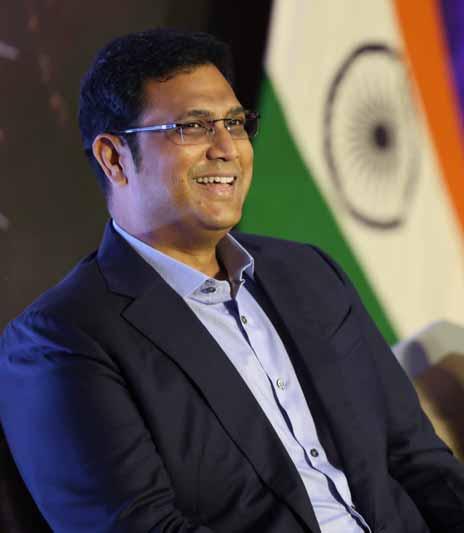
Couple this with the state’s leading position in the automobile ecosystem, and anyone can see that Tamil Nadu’s claim of being India’s EV Capital is not hollow. Leading EV investments into the state so far include Hyundai Motor India (Rs 20,000 crore), Ola Electric (Rs 7,614 crore), Renault-Nissan (Rs 5,300 crore), Simple Energy (Rs 2,500 crore), TVS Motor (Rs 1,200 crore), Ampere (Rs 650 crore) and Ather (Rs 700 crore).
While the state is trying its best to bring in world EV leader Tesla too, it is also diversifying its stakes by building two new EV parks, each spanning 300 acres. With such well-planned initiatives, the state is expecting to attract 35% of all EV investments coming into India till 2030.
To improve the local sales and adoption of electric vehicles, Tamil Nadu is also
SEASONAL MAGAZINE
Dr. T R B Rajaa, Minister for Industries and Investment Promotion
developing charging infrastructure in its 6 cities - Chennai, Coimbatore, Tiruchirappalli, Madurai, Salem and Tirunelveli, to make them EV ready. Real estate developers are also being roped in to ensure that there are enough public charging stations across various commercial and residential projects.

Electronics manufacturing is yet another domain where CM Stalin is leveraging the state’s past achievements and plotting for a massive future. Towards this, the state’s Industries and Investment Promotion Minister TRB Rajaa has been pushing an initiative to bring in at least 50% of the world’s essential component manufacturers into the state, in an attempt to deliver the entire electronics manufacturing supply chain in the state.
This can be a highly successful strategy for Tamil Nadu and India, as the world is actively looking at an alternative to China for electronics manufacturing. Already, the state machinery has been successful in engaging with 20% of the world’s leading component manufacturers, and it is now gunning for some of the biggest manufacturers from US & Talwan to set up shop in the state. The state had recently stunned the


whole of the country by edging past all other states to emerge as the largest electronics exporter with goods worth $5.37 billion dollars in FY’23, which is a tripling of the output from the $1.86 billion it achieved last year. In percentage terms, the state now accounts for 22.8% of India’s electronics exports worth $23.57 billion, and compared with the last fiscal it is more than a doubling in state-wise share, from 11.98% last year.
CM Stalin is now confident of achieving double digit export figures for the state, and towards this is looking forward to engaging with major electronic manufacturers in the
US, when a state delegation will be visiting the country soon.
If such a double digit export figure happens, TN will easily account for 50% of India’s electronic exports, and it seems very much achievable looking at the 50% share it has already achieved in computer peripherals like keyboards, mouse, scanners, monitors and printers. Already, electronics majors like Foxconn and Pegatron have major manufacturing facilities in the state that manufacture iPhones and other leading smartphones that are mostly exported. The success in electronics manufacturing is essential to Tamil Nadu as it is a vital link in bettering its prospects
SEASONAL MAGAZINE
in both EVs and smartphones.
Chief Minister MK Stalin has a glorious heritage to live up to in economic development, as DMK supremo and his Late Father M Karunanidhi has been one of the pivotal leaders who ushered in massive industrial development into the state, making Tamil Nadu rank at the top among all states in India when it came to industrialization.
At the same time, Karunanidhi was popular among the masses for his benevolent approach to the poor and the downtrodden. These two objectives are often not easy to balance, yet Karunanidhi was a master at that. So far Chief Minister MK Stalin has shown that
there is every possibility that he would easily fit into his Father’s shoes when it comes to balancing the often competing objectives of industrialization and economic support to the poor.
Apart from succeeding greatly in massive job creation that has run into lakhs of new jobs due to these recent industrial projects, there have been grassroots level initiatives for hand holding the masses in these postpandemic times, especially its poor and vulnerable like women and children.

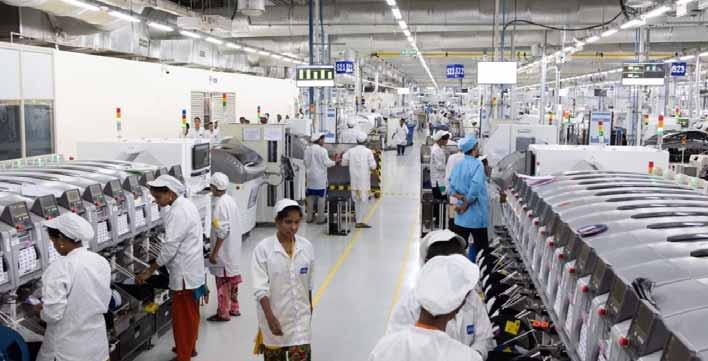
Under his personal direction and vision, Tamil Nadu is now all set to launch an innovative scheme to provide Rs 1000 per month to women heads of families. It will be launched on September 15, on the birth anniversary of DMK founder CN Annadurai.
This scheme was a major poll promise of the DMK and is titled ‘Magalir Urimai Thogai Thittam’ (Women’s Empowerment Scheme). Apart from all women family heads, unmarried, single women, widows and transgender persons also will be considered as women heads of families for the purpose of this scheme.
Foxconn
SEASONAL MAGAZINE

TESLA’S GIGACASTING IS FORCING OTHER AUTO MAJORS TO FOLLOW SUIT
HERE’S A LOOK AT GIGACASTING AND HOW THE INNOVATION IS FORCING AUTOMAKERS TO SCRAMBLE TO MATCH TESLA.
oyota Motor said this week it will adopt a technology Tesla pioneered known as “Gigacasting” as part of a strategy by the Japanese automaker to improve the performance “and lower the cost” of future electric vehicles (EVs).
Toyota is not alone in following Tesla’s breakthrough. Here’s a look at Gigacasting and how the innovation is forcing automakers to scramble to match Tesla:
The Giga Press is an aluminium diecasting machine adopted by Tesla at its factories in the U.S., China and Germany. The house-sized machines are able to produce aluminium parts far bigger than anything used before in auto manufacturing.

The “giga” in the name is a nod to Tesla’s convention of calling its plants “Gigafactories”. Other automakers have taken to calling them “megapresses”, which also can refer to smaller but still massive machines.

In operation, the press takes in a shot of
molten aluminium of 80 kg (176 lb) or more into a mould where it is formed into a part, released and then quickly cooled.
Tesla has developed an aluminium alloy that also allows it to skip the heat treating traditionally used to increase the strength of the cast part. Typically more than a hundred individually stamped metal parts have been welded together to make a car body.
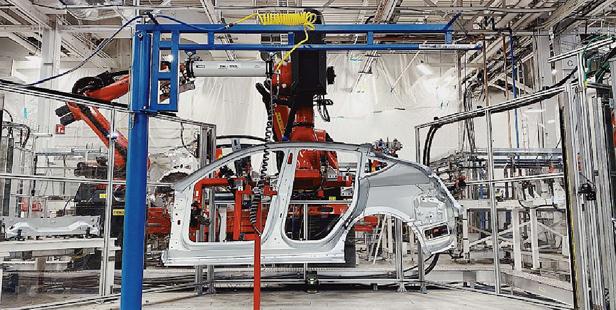
Fewer parts, lower costs and a simplified production line have contributed to Tesla’s industry-leading profitability, analysts have said.
For Tesla, the use of a single component in the rear of the Model Y - its best-
selling model - allowed it to cut related costs by 40%, the company has said.
In the Model 3, by using a single piece from the front and rear of the vehicle, Tesla was able to remove 600 robots from assembly, Elon Musk has said.
It can also cut a vehicle’s weight, an important consideration for EVs where the battery pack alone can weigh more than 700 kg. And it has the potential to reduce waste and greenhouse emissions from a plant.
Toyota said it expected that using aluminium die-casting would eliminate dozens of sheet metal parts from assembly and reduce waste.
Tesla sources its presses from Italybased IDRA, which has been a unit of China’s LK Industries since 2008.
Competitors of IDRA and LK include Buhler Group in Europe, Ube and Shibaura Machine in Japan, and Yizumi and Haitian in China.
The global aluminium die-casting market was worth almost $73 billion last year and is projected to top $126 billion
AUTO SEASONAL MAGAZINE
TESLA HAS DEVELOPED AN ALUMINIUM ALLOY THAT ALSO ALLOWS IT TO SKIP THE HEAT TREATING TRADITIONALLY USED TO INCREASE THE STRENGTH OF THE CAST PART.
by 2032, showed an AlixPartners analysis.
In addition to Toyota, General Motors, Hyundai Motor and affiliates of China’s Geely Volvo Cars, Polestar and Zeekr - are using the technology or planning for it.
Zeekr has started using massive aluminium die casts for a multipurpose van it makes for sale in China and has said it will introduce the technology for other models.
Volvo said last year it would invest more than $900 million to upgrade its plant near Gothenburg, Sweden, to include megapress technology.
So, what is the catch? Cost is one. Tesla records most of its sales with just two models: the Model 3 and Model Y. High sales volume on just two platforms make it easier to justify the investment in new production technology. Other EV startups also have that advantage.
For legacy automakers with more complicated product lineups and factory machinery that is already amortised, the decision to invest tens of millions of dollars in new casting technology can be a harder call, analysts have said.
Cars with body sections cast into single pieces could also be harder or more expensive to repair after an accident. That could add to the cost of operation for EVs.

Already insurance companies are writing off EVs with low mileage if they have damaged batteries because there is often no way to repair even slightly damaged battery packs.
HEALTH MINISTRY SENDS NOTICE TO 15 WEBSITES SELLING E-CIGARETTES

The Union Health Ministry has sent notices to 15 websites selling ecigarettes, directing them to stop advertisement and sale of the products, PTI reported. Six more websites are on the radar and the government is also closely monitoring the advertising and sale of e-cigarettes on social media. The Prohibition of Electronic Cigarettes Act, banning ecigarettes, came into force in 2019.
TESLA DIRECTORS PAY $735 MN OVER CLAIMS THEY OVERPAID THEMSELVES

Elon Musk-owned Tesla's directors will return $735 million to settle claims from shareholders that they excessively overpaid themselves, according to a court filing. The directors, including Musk and Oracle Co-founder Larry Ellison, were accused of awarding themselves unfair and excessive compensation using 11 million stock options from 2017 to 2020. A retirement fund had filed the lawsuit.
NEVER EXPECTED TO HAVE EMPATHY FOR A DOLL: BARBIE ACTRESS MARGOT

Hollywood actress Margot Robbie, who will be seen in the upcoming film 'Barbie', said that she "never expected to have this much empathy for a doll". "I didn't know this character was going to get down into my bones in this way," Margot said. "I just didn't ever expect to have so many...profound conversations about...what true happiness is," she added.
MORE THAN 50 WHALES DIE AFTER MASS STRANDING ON SCOTLAND BEACH
A pod of more than 50 pilot whales have died in Scotland after being stranded on a beach. This is reportedly the largest mass stranding in the country in decades. British Divers Marine Life Rescue suspected that the entire pod was stranded after one whale suffered birthing complications. A decision was taken to euthanise the remaining whales on welfare grounds.

BUFFETT SOLD 70% ACTIVISION STAKE BEFORE MICROSOFT MERGER GOT NOD
Billionaire investor Warren Buffett sold 70% of his firm Berkshire Hathaway's stake in video game maker Activision Blizzard in April-June quarter before a US court approved its merger with Microsoft. Berkshire said it owned 1.9% stake worth $1.24 billion in Activision on June 30, down from 6.3% on March 31. One of Berkshire's employees had invested in Activision in 2021.

SEASONAL MAGAZINE
WHEN RATAN TATA HANDHOLDS
WHEN RATAN TATA HANDHOLDS

HOW RATAN TATA HELPED THIS 21-YEAR-OLD MAN BUILD A RS 500 CRORE COMPANY. THE MUMBAI-BASED STARTUP HAS THE BACKING OF LEGENDARY INDUSTRIALIST RATAN TATA WHO WAS IMPRESSED BY THE COMPANY’S INNOVATIVE MODEL.

hen Arjun Deshpande was 16, he founded a company that offered medicines at a cheaper rate than usually available in the market. At 21, Deshpande is the CEO of Generic Aadhaar which sells generic medicines via its chain of franchisees at 80-90 percent discounts. The Mumbai-based startup is now worth Rs 500 crore and has the backing of legendary

industrialist Ratan Tata.
Generic Aadhaar removed the chain of intermediaries such as marketers, distributors, and stockists, to cut down costs significantly. For example, diabetes drug Glimipiride, which normally retails for Rs 110 per strip, is available a little over Rs 5 through Generic Aadhaar, whereas anti-allergen Levocetrizine, which usually retails for Rs 55, is available for under Rs 6 per strip.
In its first couple of years, Generic
Aadhaar expanded rapidly across cities and won Deshpande his first TED talk which went viral and caught Ratan Tata’s attention. Impressed by the company’s innovative model, the industrialist offered to invest in the venture. Since then, Ratan Tata has helped Generic Aadhaar reach the last mile of the country. Now, the startup has 2,000 stores across the country, a manpower of nearly 10,000.
In April, Arjun Deshpande was lauded by President Droupadi Murmu for his dedication to making affordable medicine to Indian citizens and acknowledged Generic Aadhaar’s work is contributing to the growth of the economy. She also called Deshpande the “wonder kid of pharma”. Currently, the company is working on expanding to Bangladesh, Nepal, Bhutan, Sri Lanka, UAE, and Myanmar. “We will be shortly opening our stores in Dubai, Oman, Cambodia, and Vietnam as well,” Deshpande had said. Also, the company aims to increase it’s stores to 3,000 while entering into the veterinary space. The 21-year-old CEO Arjun believes medicines for animals available at low prices would reduce the financial stress of the farmers. The company recently opened its first veterinary store in Andhra Pradesh.
(Credit: Moneycontrol)
START-UP
SEASONAL MAGAZINE
HEALTHCARE LOOKS BEYOND BMI
HEALTHCARE LOOKS BEYOND BMI
BMI HAS MEANT SLAPPING AN “OVERWEIGHT” OR “OBESE” LABEL ON SOME PEOPLE WHO ARE PERFECTLY HEALTHY, WHILE OVERLOOKING OTHERS WHOSE BMI IS CONSIDERED NORMAL, BUT COULD USE BETTER GUIDANCE ON EXERCISING OR EATING HEALTHY FOODS
he American Medical Association has now weighed in to say that doctors should look at factors beyond BMI to determine whether a patient is unhealthily obese.


The scales are formally shifting on Body Mass Index, a measurement that has been the source of much scorn in recent years. The American Medical Association has now weighed in to say that doctors should look at factors beyond BMI to determine whether a patient is unhealthily obese.
Finally, medical science is looking beyond this nearly 200-year-old formula. It was devised not by a doctor, but by an astronomer. He used it to define what was “normal” — a normal based on White, 19th-century European men. Now comes the tricky part: Shifting the way doctors and society define a healthy size — and ensuring people trying to lose weight can get the interventions they need.
BMI is someone’s weight in kilograms divided by the square of their height in meters. That mathematical approach has been used to stigmatise and even misdiagnose a swath of the population. It means a skewed view of population’s health. And it has meant slapping an “overweight” or “obese” label on some people who are perfectly healthy, while overlooking others whose BMI is considered normal, but could use better guidance on exercising or eating healthy foods.
Everyone has had personal experiences that illustrate the problems with BMI. I still can’t shake the visceral reaction I had some years ago when a pediatrician began talking about her concerns about my kindergartner’s BMI. My daughter had stepped on the scale at the end of a summer where she treated mastering
the monkey bars as her full-time job. The kid was ripped. Could the doctor not see that?
Yet pediatricians have leaned on BMI more and more over the years. A survey published last year found that by 2017, 95 percent of pediatricians were calculating BMI for their patients over the age of 2, compared to less than 40 percent of doctors in 2006. Many schools even added the measurement to report cards, despite no evidence that it influenced children’s weight.
Doctors’ time and energy would be better spent on other approaches to improving our nation’s health. As the AMA guidelines reiterate, BMI shouldn’t be looked at in isolation. The data are murky around when BMI is and is not an indicator of someone’s chances of developing diseases like diabetes and heart disease, or their risk of dying younger.
That doesn’t mean those health risks don’t exist, but it does mean that doctors should be using BMI alongside a more comprehensive list of health indicators. They should consider things like someone’s waist circumference, genetic risks for disease, body composition and their amount of
visceral fat, or the fat that sits not just beneath the skin, but behind your muscles (people with an apple rather than pear shape typically have more visceral fat). The AMA’s new position should help shift the conversations between doctors and their patients.
But we do need to consider that releasing ourselves from the confines of the dreaded calculation could also further complicate people’s ability to access interventions. BMI is often used as a cutoff for access to certain treatments, and we can’t allow it to get even harder for people to access care they want and need, whether that’s weight-loss drugs like Ozempic and Wegovy, bariatric surgery or behavioral interventions. Indeed, the AMA also stressed that given differences in body shapes and fat distribution across people of different races, ages and genders, “BMI should not be used as a sole criterion to deny appropriate insurance reimbursement.”
Given the increasing prevalence of obesity and the projected astronomical cost to the economy (with the caveat that these numbers are calculated based on BMI!), it makes perfect sense for doctors to discuss healthy habits. But the conversation should be focused on health, not math.
(By Lisa Jarvis for Bloomberg)
HEALTH SEASONAL MAGAZINE
e’ve all been there: you find a great job opportunity, submit your CV and then wait, hoping against hope that you’ll receive a response. Unfortunately, more often than not your applications are met with radio silence and you’re left wondering what you could have done differently.
Lather, rinse and repeat. The process can be exhausting at best and incredibly demoralising at worst, especially when your applications keep falling into the notorious ‘CV black hole’. But while you won’t have control over every circumstance that affects your candidacy, there are things you can do – or mistakes you can avoid – to
improve your chances of landing a job interview.


Below are some of the most common mistakes people make when applying for jobs, and what you can do to avoid any mishaps.
1) YOU USE THE SAME CV FOR MULTIPLE JOB APPLICATIONS
Even though you’ll apply for many similar positions, no two jobs are ever exactly the same. The best way to increase your chances of landing an interview is by tailoring your CV for each application.
This process may include swapping out some of the skills listed in the Skills or Core Competencies section of your CV, reordering your accomplishments under

a past role to emphasise relevant work examples or changing some of the wording in your CV to match the phrases found in a particular job advert.
If you’re unsure how to properly customise your CV for a role, start by taking a closer look at the job description and requirements to identify what phrases or terms are repeatedly mentioned; these probably belong in your CV if they speak to your skills and experience. Also, take note of what hard and soft skills are considered most important for the job.
Then, take a closer look at your CV to make certain your qualifications are properly highlighted throughout the document. Don’t assume the viewer will take the time to read between the lines.
CARRIER SEASONAL MAGAZINE
Keep firing out CVs and getting zilch back? You might be making one of these five common job application mistakes.
For example, if you are applying for a remote job, make sure you note which of your previous positions involved working from home on a hybrid or fulltime basis.
2) YOUR CV JUST OUTLINES YOUR DUTIES, NOT YOUR VALUE
Employers want to see more than a timeline of your education and experience. They want your CV to explain why you’re qualified for the job you want. Instead of simply listing your responsibilities, explain what you achieved or how you contributed to your department while performing your duties. In other words, offer proof of your qualifications by including specific examples, figures or case studies that illustrate your abilities. Wherever possible, quantify your contributions and achievements to show the value you’ve created for your past employers.
Remember, your CV is not the place to be modest. This is your opportunity to proudly brag about all the great things you’ve accomplished at your positions: promotions earned, sales made, costs cut, customers gained, etc.
Even if the roles you previously held didn’t come with much responsibility, you can still demonstrate that you were good at what you did and identify any transferable skills. Quantifying your work can help the reader appreciate the depth of your experience and the value you can bring to an organisation.
3) YOU PUT TOO MUCH TRUST IN SPELLCHECK
In an era when we have access to tools like Grammarly and TopCV, there’s no excuse for having careless typos on your CV. However, thanks to our overreliance on spell check and use of shorthand in texts, job seekers are still unknowingly submitting applications that are riddled with errors. Don’t let a simple CV mistake hurt your chances of landing the job. You can easily avoid this top CV ‘deal-breaker’ by taking a few extra minutes to carefully proofread your application.
Start by making a copy of your CV file, changing the font to something other than what you plan to use for your final
application, and then printing it out. Our brains read words in print more carefully than when we read them on a screen. Read your CV aloud to pick up any awkward phrasing or repetitive language you’ll need to adjust. If you trip over your words when reading your CV out loud, you can assume the recruiter will have the same issue. Also, silently read your CV a second time starting at the bottom and working your way up. This will also help you catch any errant typos. In addition, ask a trusted friend to give it a final read before you start applying for jobs.
4) YOU DIDN’T ACCOUNT FOR THE ‘ELECTRONIC GATEKEEPER’
While it’s important to consider what a recruiter or hiring manager looks for when writing your CV, that’s only half of your application’s journey. Before your CV can impress an employer, it must first get past their applicant tracking system — or ATS, for short. This recruitment technology analyses and organises a company’s online applications to filter out the leastqualified candidates.
To ensure your CV is ‘ATS-friendly’, use a simple format that utilises clearly marked headers and that doesn’t include images or unusual fonts. If you plan to use a CV design that contains columns, opt for one that places the skinny column on the left side of the document. Unfortunately, CVs with a right-hand column do not successfully pass through the ATS.
Most importantly, customise your CV with relevant keywords found in the job advert. Take a second look at the job description to identify which keywords and phrases are frequently used throughout the advert and speak to the job requirements. Incorporate these terms as they appear in the job
USE YOUR DIGITAL FOOTPRINT TO SUPPLEMENT YOUR CV. FOR EXAMPLE, YOU CAN USE YOUR LINKEDIN PROFILE TO POST CONTENT YOU’RE PASSIONATE ABOUT, LINK TO EXAMPLES OF YOUR WORK OR EVEN RECORD A VIDEO INTRODUCING YOURSELF TO POTENTIAL EMPLOYERS.
description throughout your CV.
5) YOUR CV AND YOUR ONLINE PRESENCE ARE TELLING TWO DIFFERENT STORIES
These days, it’s not enough to have a well-written CV; if you want to impress employers and land the job, you need to consistently communicate your goals, skills and qualifications on paper, online and in person. It’s common practice for recruiters to review your online brand along with the CV you supplied.
Take a moment to Google your name as it appears on your CV and see what results pop up. Then, make a list of all the social media platforms and job boards where you have set up accounts. If you plan to use an account as part of your job-search efforts, make sure the information is updated to reflect the details found on your current CV and any improper photos or posts are taken down or untagged from your profile. The last thing you need is some old unsavoury photo of you tainting your reputation with a hiring manager.
If there are accounts you don’t want employers to associate with your candidacy, then you can either shut them down, make the accounts private by increasing the security settings or change the account name to a nickname that won’t be linked back to your professional brand.
If your name is very common, you might want to include your middle initial on your CV and any social profiles you’re using to support your job search. Also, if you have any noteworthy credentials, consider including them after your name (e.g., ‘Charlotte Barrett, MBA’ or ‘Jane Pember, CPA’).
Use your digital footprint to supplement your CV. For example, you can use your LinkedIn profile to post content you’re passionate about, link to examples of your work or even record a video introducing yourself to potential employers.
Avoid these common — and costly — mistakes during your next job application, and your chances of landing the job are sure to improve.
(Credit: Amanda Augustine, Career Expert for Talent Inc., for Stylist)
SEASONAL MAGAZINE
HIGHER EDUCATION


THERE WAS A TIME WHEN INDIA COULDN’T ORIGINATE MUCH WORLD-CLASS MEDICAL RESEARCH. SUCH TIMES ARE SLOWLY BUT SURELY CHANGING, AND AT THE FOREFRONT OF USHERING IN THIS CHANGE IN INDIAN CAPABILITIES IS MYSURU HEADQUARTERED LEADING DEEMED UNIVERSITY, JSS ACADEMY OF HIGHER EDUCATION & RESEARCH. UNDER THE GUIDANCE OF ITS CHANCELLOR JAGADGURU SRI SHIVARATHRI DESHIKENDRA MAHASWAMIJI, PRO CHANCELLOR DR. B SURESH AND VICE CHANCELLOR DR. SURINDER SINGH, THE UNIVERSITY IS ALSO EXCELLING IN ACADEMICS AND RANKINGS.

ecently, a study by scientists of JSSAHER showed that a dietary flavonoid found in abundance in certain fruits and vegetables has significant therapeutic benefits on breast cancer and breast cancer-induced liver inflammation and fibrosis. This study garnered worldwide attention especially as this natural compound Quercetin has a biological action that mimics Vitamin D. Around 100 crore people across the world suffer from Vitamin D deficiency and 49 crore of these people are in India, and the study’s lead author Prasanna Santhekadur, Associate Professor, Department of Biochemistry, JSS Medical College, informed that Vitamin D deficiency is a proven risk factor for developing breast cancer. This is primarily because of people spending too much time indoors, which is not easily reversed, due to new age phenomena like nuclear families, too many working hours, night-shifts and work-from-home. Here is how this new discovery of Quercetin’s specific power against breast cancer complications shines through, as this dietary flavonoid is found abundantly in several fruits, vegetables and beverages including apples, grapes, berries, onions, tea and red wine.This study was published recently in the noted medical journal
‘Frontiers in Nutrition’, was a collaborative effort led by Prasanna along with his three PhD students, and colleagues from Department of BioChemistry, JSS School of Life Sciences, JSS Dental College and Department of Anatomy at JSS Medical College. A funded project, it was financially
supported primarily by India’s Department of Science and Technology, and partly supported by the the country’s Department of Biotechnology and Karnataka state’s Science and Technology Academy. The design, execution and groundbreaking outcomes from such studies conducted
SEASONAL MAGAZINE
by JSSAHER
research scholars signal the high level of maturity with which the research initiatives of this deemed-to-be university are undertaken. The domain of Pharmacy is another one where JSSAHER has a natural and conventional edge. The JSS Pharmacy College, which is a constituent of JSSAHER, had recently organised its Graduation Day programme. 271 candidates received their certificates on completion of their courses and this included 87 candidates who had completed their BPharm, 40 who had completed PharmD, 54 who had completed DPharm and 90 who were eligible to receive MPharm certificates. The college enjoys leading rank in national level pharmacy rankings, and its achievements were lauded by Shailendra Sharaf, Director, National Institute of Pharmaceutical Education and Research, Ahmedabad, who was the chief guest at the event. The college is also celebrating its golden jubilee this year, proving itself as one of the most mature players in pharmacy education in India. The various initiatives of JSSAHER is also getting noticed internationally. Recently, JSS Medical

College, the flagship of JSSAHER, organised the Asian Medical Students Exchange Programme (AMSEP), under which 10 students from Tzu Chi University, Taiwan and three students from AMSEP National Board were hosted in the campus of the institution. JSSAHER also continued to excel in NIRF rankings as this year’s achievements show. For the eights year in a row, JSSAHER positioned itself within the top 50 in NIRF rankings. It retained its 34th position as a University and improved in overall ranking category from 60th to 55th position among 8,686 participating universities, colleges and institutions, which is an exemplary feat. The constituent colleges of JSSAHER also did well with JSS College of Pharmacy in Ooty and Mysuru getting positioned within top 10 Pharmacy Colleges in the country, with ranks fourth and seventh, while JSS Dental College, Mysuru, was ranked 11th and JSS Medical College, Mysuru, getting ranked at the 37th position. Signalling the overall achievements of JSSAHER in this regard, it is the only Health Sciences and Life Sciences focused University to find position among top 50 Universities in the country.

SEASONAL MAGAZINE
Dr. B. Suresh Pro Chancellor
QUESTIONS PRODUCTIVE

YOU HAVE A PROJECT DEADLINE, SO WHY ARE YOU WATCHING CAT VIDEOS ON FACEBOOK?
hamburger for lunch, it could make you groggy in the afternoon. High-fat foods require your body to work harder, leaving you with less energy for difficult mental tasks. Fruits and vegetables have the opposite effect. It’s now scientifically proven that fruits and veggies keep you more engaged, more creative, and happier.
4. HOW OFTEN DO YOU EAT?
t happens to everyone. You sit down to finish a project, but before long your mind wanders to something entirely new. Facebook starts calling. You begin browsing on Amazon. And somehow you end up watching cat videos on YouTube.
Don’t worry; you aren’t doomed to forever be a scatterbrain. There are factors that can boost or break your focus. But productive people know how to work around distractions. Begin by checking on yourself with these five questions.

1.HOW LONG HAS IT BEEN SINCE YOU’VE TAKEN A BREAK?
Sometimes, you’re just tired. Even if you don’t feel physically tired, a mental break is beneficial. A study published in Cognition found that people function more effectively when they have brief mental breaks. When our external stimuli — for example, what we see and hear — remain the same, our brains gradually stop registering those stimuli. We pay more attention to things that are
new. So don’t stare at the same Word document for too long. Stand up, stretch, or spend some time on another task to stay focused.

2.ARE YOU RUNNING ON A GOOD NIGHT’S SLEEP OR JUST CAFFEINE?
We’ve heard it a million times. Adults need eight hours of sleep. In reality, each person’s needs vary slightly. But if you can only get through the day with five cups of coffee, you might need to set an earlier bedtime.
Unfortunately, catching up on your sleep during the weekend doesn’t work. A Harvard Medical School study found that even with 10 extra hours of sleep, participants’ ability to focus was less than those who received consistent sleep throughout the week. The solution: Take sleep seriously.
3. WHAT HAVE YOU BEEN EATING?
Whether it’s surprising to you or not, the food you eat affects your focus. While there’s nothing wrong with grabbing a
Most people go to work, power through any mid-morning hunger pangs, and eat a lot during lunch. But it’s better to “graze” throughout the day. The traditional meal pattern puts your body through dramatic energy drops and spikes, which is bad for productivity and self-control. Snacking fuels your body by giving it a more consistent source of energy. Keeping yourself from reaching a point where you’re starving also helps you make better decisions. We often make unhealthy food choices because we don’t decide what to eat until we’re hungry. When you’re mentally worn out and hungry, fast food is appealing.
5.IS THERE AN ISSUE THAT’S STEALING YOUR FOCUS?
Sometimes, taking better care of your health won’t be enough to beat low productivity. If there’s an issue that’s bothering you (personal or professional), you may need to dedicate time to it. Try setting aside a specific time to address the issue. Dedicating time can mean anything from saving an hour slot in your workday for a task, meeting a friend after work to get something off your chest, or even seeing a professional counselor to work through a difficult event or transition. If you never give your brain a chance to process challenging situations, that’s where your mind will wander when your defenses are down.
(Credit: Rhett Power for Inc.)
SEASONAL MAGAZINE PRODUCTIVITY

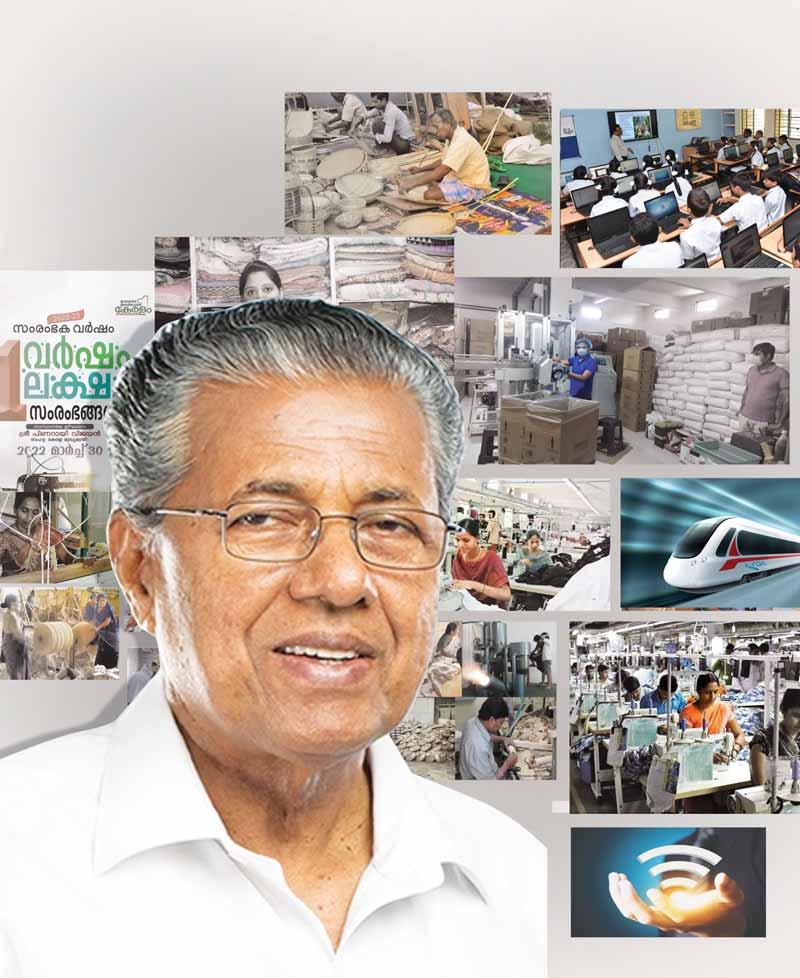
STATE SEASONAL MAGAZINE
Kerala has never been among India’s most industrialised states, and it may never emerge in such lists too, but that is because Kerala’s priorities have always been different. No one exemplifies this unique set of priorities as much as its Chief Minister Pinarayi Vijayan. For instance, equitable development by way of say, high average wages, is something about which the man on the street and this Chief Minister are equally passionate about. CM Vijayan is just back from a 12-day whirlwind tour of the USA, Cuba & UAE, which included a well-attended speech at the iconic Times Square in New York where the CM explained Kerala’s progressive values, social harmony & equitable development. This has resulted in Kerala maintaining its lead in the Human Development Index (HDI) parameters, with its infant & maternal mortality rates not just the best in India, but comparable to developed nations. Under CM Vijayan’s seven years of leadership, the state has achieved many firsts to its credit. Kerala is the first state in India to have a state-owned broadband fibre optic network, first state to achieve full eGovernance, first state to have a programme to eradicate extreme poverty, and home to India’s first Super FabLab, first Digital University, first Graphene Center and first Water Metro. While the state has unique challenges in attracting large scale manufacturing industries, it has fared quite well under CM Vijayan’s tenure in growing its MSMEs and startup ecosystem. In fact, during CM Vijayan’s recent stopover at Dubai, he inaugurated Kerala Startup Mission’s (KSUM) first ever Infinity Centre in this international city. Always a leader who leaves the numbers to do the talking, CM Vijayan’s track record of 81% GSDP growth and 54% per capita income growth during the past 7 years is indeed a benchmark to beat.
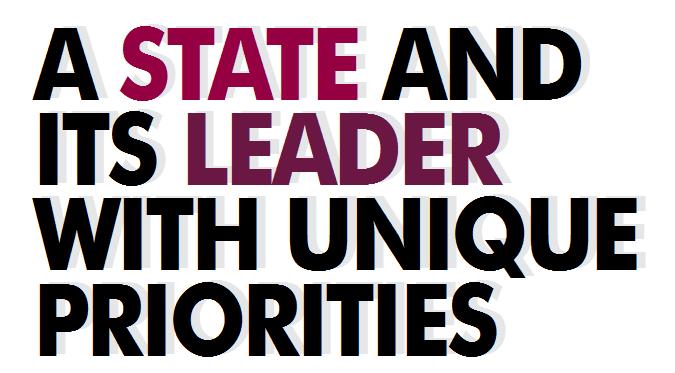

SEASONAL MAGAZINE
ver heard of a state in India declaring the ‘right to internet’ as a basic right? Not likely, as Kerala was the first state to do it in India, and maybe the only state in the country to ever attempt this in the future too. And if you are wondering what was the need for such a declaration also, you can’t be blamed. Only the people of Kerala and their Chief Minister Pinarayi Vijayan are sensitive to such deep felt needs in the society. This declaration was no hollow promise, as the whole of India found out recently, when CM Vijayan launched the much awaited Kerala Fibre Optic Network (KFON) project, which is Kerala Government’s unique initiative to provide internet connectivity for all households in the state. Yes, of course, many households in this relatively affluent state don’t need it at all. But that is not the point.
KFON will reduce the digital divide by ensuring high speed broadband internet access to 14,000 BPL families and 30,000 government offices at all tiers, across the state. If you still think that it has been a hasty project or even an illconceived one, wait till you hear the full details. Under the visionary leadership of CM Vijayan, the state has chosen the very best-in-class consultants, designers &

implementers for KFON. While PriceWaterhouseCoopers is the consultant of the Rs. 1611 crore project, the implementation and system integration is by India’s bluechip Central PSU Bharat Electronics Limited. The vision of CM Vijayan for KFON is that it will speed up the development of Kerala as a knowledge economy as well as accelerate the kind of e-governance needed in the coming decades.
In fact, Kerala has become India’s first fully e-Governed State on 25th May 2023. It is a historic milestone in the internationally acclaimed Kerala model of development and social progress. This is not something that Kerala achieved overnight. It was built upon the foundation of declaring ‘right to internet’ as a basic right of Keralites, during CM Vijayan’s previous tenure, and later following it up with the introduction of the Kerala Fibre Optic Network (K-FON).
While the K-FON project was launched formally only recently, CM Vijayan had ensured that it hit the ground running. By the time of its launch itself, Kerala had set up 2000 WiFi hotspots using the K-FON network. These hotspots are free for the public to use, and since it included government offices too, it became a major step in the state’s e-governance initiative. Another 2000 WiFi
hotspots are now in the pipeline. While this is about digital infrastructure, the CM had a similar vision of development for the Silverline or K-Rail project too, which unfortunately has run into rough weather for now. But nobody who knows Pinaray Vijayan up-close will imagine that he will forsake such visionary projects, just because it has run into temporary hitches. He is one CM who really knows what will work in Kerala.
Due to its relatively high population, less land area and high living standards as measured by one of the highest Human Development Index (HDI) values in the country, Kerala has always had unique challenges when it came to economic development by attracting large scale investments. But then Kerala’s priorities have always been vastly different, for instance, its emphasis on ensuring equitable development at any cost.
The finest example for this ethos is the state’s unique programme to eradicate extreme poverty, which is the only such initiative by any state in the whole of India. This is despite Kerala having one of the lowest levels of extreme poverty in the country. According to NITI Aayog, only 0.7 % of Keralites experience multidimensional poverty. But taking even this low level seriously, CM Vijayan had hiked welfare pensions to Rs. 1,600 per month, which is the highest in the country. Around 63 lakh people currently benefit from this.
Several other welfare measures too have been implemented for the benefit of the economically weaker sections of Keralites, some of which deserve special mention. Under CM Vijayan’s leadership, Kerala has built homes for 3.5 lakh families, given title deeds to 3 lakh people, and issued priority ration cards to 3.5 lakh families. Kerala also provides health insurance to 43 lakh families
 SEASONAL MAGAZINE
SEASONAL MAGAZINE
and 30 lakh people who are government servants - including retired personnel and their dependents - who benefit from this scheme titled Medisep.
Education, healthcare, literacy and the care given to its children are other areas where Kerala has been pursuing equitable development. Kerala has been the most literate state in the country, and its infant and maternal mortality rates are at par with developed countries, and not just the best in India. Under CM Vijayan’s leadership, Rs. 3,800 crores has been invested for the modernisation of Kerala’s public schools and Rs. 19,000 crores has been invested in the state’s public health system.
No wonder then that Kerala’s staterun schools and hospitals have been adjudged as the best in the country by several agencies including the NITI Aayog. Recently Kerala also topped the State Food Safety Index 2023 in the ‘Large States’ category. It is undoubtedly a recognition for the Government of Kerala’s committed efforts in the sector, including the implementation of a Safe and Nutritious Food Scheme in Kerala’s government and aided schools.
On the infrastructure front, even though its most ambitious K-Rail project has run into rough weather for now, the government has been forging ahead with multiple smaller projects. The scheduled development projects of National Highways and National Waterways are nearing completion. The Hill Highway and the Coastal Highway are also being built at a cost of Rs. 3,500 crores and Rs. 6,500 crores respectively.
Kerala has unique challenges when it comes to implementing large scale industrial projects, which the state is overcoming in innovative ways. Geographically speaking, many areas of this narrow state wedged between
Arabian Sea on the West and Western Ghats on the East, are ecologically fragile or sensitive, which makes large scale industrialization, especially of the manufacturing and polluting kind, impossible in the state.
Kerala had long countered these challenges by focusing on its strengths like its natural beauty, for growing its tourism industry, which catapulted ‘God’s Own Country’ into being one of the leading tourist destinations for domestic and overseas travellers. Kerala had also made some inroads into IT and IT Enabled Services, by establishing or facilitating various tech parks in Thiruvananthapuram and Kochi, even though it fell short of the progress made by its neighbours Karnataka and Tamil Nadu in this regard.
But after many false starts and trials, the state under the veteran leadership of Chief Minister Pinarayi Vijayan seems to have found two new niches where it is silently making much progress. Firstly, the state had designated FY’ 23 as the ‘Year of Enterprises’ with an aim of facilitating the launch of at least 1 lakh new Micro, Small & Medium Enterprises (MSMEs).
This Year of Enterprises scheme resulted in the setting up of around 1,40,000 enterprises at an investment of Rs. 8500 crores and generated about 3,00,000 new jobs. Despite the Opposition contesting

some of these numbers, this has since then been hailed across India as a best practice in giving a fillip to the most crucial MSME segment of the economy, which is credited with the maximum job generation in the country. There is no doubt that Kerala has made some significant headway in this crucial sector due to this scheme.
Similarly, unknown to many, Kerala has been carving out for itself a significant space in the country’s startup ecosystem. Between 2016 and 2021, over 4000 startups were launched in Kerala. While most of them are still bootstrapped startups, the bigger among them have cumulatively raised $551 million in funding across 110 funding deals, since 2015. Today, Kerala’s startup ecosystem is being recognized as one of the finest in the country.
Kerala’s strength in startups lie in the fintech and SaaS space, with these startups securing the highest VC funding of $364 million (66%). Recently the state government’s startup arm, Kerala Startup Mission (KSUM) had organised the Seeding Kerala Conclave, an investors and startups meet, where Sparks Angel Network, Kerala Angel Network and Phoenix Angels announced plans for investing Rs. 8 Cr, Rs. 5 Cr and Rs. 4.95 Cr respectively in Kerala-based early-stage startups.
Some of the recent government initiatives in science, technology and
SEASONAL MAGAZINE
higher education are also helping the state’s startup ecosystem in a big way. Examples of such projects include Kerala setting up India’s first Super FabLab, India’s first Digital University, India’s first Graphene Center and India’s first Water Metro. The foundation stone has also been laid for India’s First Digital Science Park.


Under CM Vijayan’s leadership, Kerala is encouraging startups as a long-term solution to employment generation. Despite having made close to 2,07,000 appointments through the Kerala PSC and having created around 30,000 new posts in the government services, the pragmatic leader in CM Vijayan knows that the times have changed and that it is more fruitful to enable and facilitate the innovative spirit in its young entrepreneurs.
Pinarayi Vijayan is one leader who boasts little but lets the numbers speak for itself. In 2016 when the LDF Government led by him came to power, Kerala’s unemployment rate was 12%. Under his leadership, it has been brought down to 5%. Kerala’s Gross State Domestic Product (GSDP) was Rs. 5,61,994 crores in 201516, and It has grown to Rs. 10,17,873 crore in 2022-23.
This has been a phenomenal growth of 81% in seven years. Similarly, Kerala’s annual per capita income has risen from Rs. 1,48,133 to Rs. 2,28,767 over the last seven years, which too is a spectacular growth of 54%. With such a sound track record there is no doubt that Kerala is in safe hands for years to come.

SEASONAL MAGAZINE

TO ITS OWN STRENGTHS IS SEEMATTI’S STRATEGY IS SEEMATTI’S STRATEGY

TO ITS OWN STRENGTHS
RETAIL SEASONAL MAGAZINE
SEEMATTI
WORKING OUT? OF PLAYING OF PLAYING
WORKING OUT?
THERE WAS A TIME WHEN EVERYONE WROTE OFF KOCHI’S ORIGINAL CENTRAL BUSINESS DISTRICT OF MG ROAD AND TOGETHER WITH IT, ITS FAMED SHOPS LIKE THE TEXTILE MAJOR SEEMATTI. SUCH WAS THE NEW MEGA MALL PROJECTS GETTING LAUNCHED IN THE NEW HOTSPOT OF EDAPPALLY. BUT NO ONE HADN’T COUNTED ON THE RESOLVE OF ITS CEO & CHIEF DESIGNER, BEENA KANNAN. HERE IS A LOOK INTO WHETHER HER STRATEGIES HAVE PLAYED OUT WELL FOR SEEMATTI.

SEASONAL MAGAZINE
BEENA KANNAN
ompetition has been heating up in recent years for Seematti at Kochi, with retail chains owned by international and national level retailing chains, major brands from neighbouring states like Tamil Nadu, and homegrown retailing brands all setting shop in the city. Kochi also saw the opening of a few mega malls, most of them near Edappally, with multi-brand and singlebrand textile showrooms.

But, unlike what most people would have expected, under the leadership of its CEO & Chief Designer, Beena Kannan, Seematti had responded by limiting Seematti’s footprint to just MG Road’s North End, but expanding it to multi-times its original size in this location.

Beena Kannan has single-handedly expanded and modernised not only her textile mall into a sprawling 5 lakh square feet fashion venue, but transformed the entire north end of MG Road, traditionally called the Madhava Pharmacy Junction, to a new kind of glory it never had. This shopping destination is now complete with a high-end Fashion TV Salon for celebrities and aspiring celebrities, as well as eateries of buzzing homegrown brands like Topi Vappa
Biriyani and Kozhi.in Fried Chicken.
For this, the astute businesswoman in Beena Kannan bought a 25-year old commercial complex facing Seematti at the other side of the road and gave the dull-looking 12,000 sq ft building a radical makeover with cement boards and wall paintings.
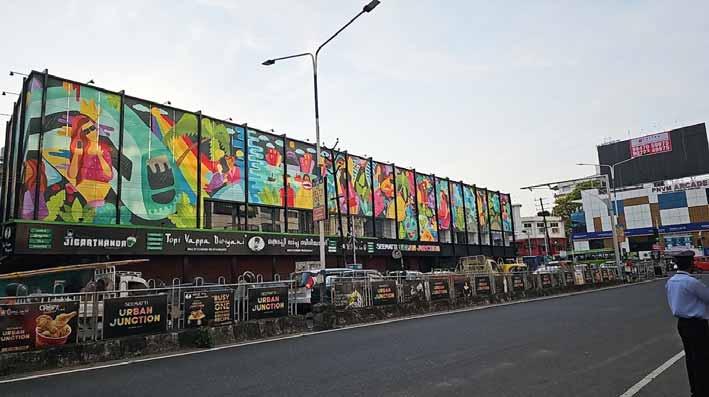
While ace designer Sreejith Menon handled the overall design and aesthetics, the 6000 sq ft wide wall paintings were done by noted mural and graffiti artist Aathira Mohan who did it while dangling for days on a harness.
The final look is stunning to say the least, with wall paintings that capture the essence of Kochi, with depictions of its sea, fishes, marine drive, rainbow bridge and metro. Today, the Madhava
SEASONAL MAGAZINE
Pharmacy Junction is being called Seematti Urban Junction, and it will be no wonder if the new name eventually holds in the public imagination, as so much thought and work have gone towards this makeover. However, only time would tell whether this will help the brand in sheer growth terms, compared with what could have been possible if Seematti had opened branches in Edappally, Kakkanad and other such emerging hubs.
Seematti Founder and Beena Kannan’s grandfather Late S Veeriah Reddiar who started the brand with a 4000 sq ft shop in Alappuzha in 1910 and her father V Thiruvenkitam who expanded the business and gifted her Seematti Kochi can be proud of their daughter’s achievements of not only guarding the Seematti legacy, but growing it to dizzying heights that they most probably couldn’t have foreseen.
Brand Seematti is in full synergy with Brand Beena Kannan as she carries her image as both a business tycoon and as a style and fitness icon with equal elan. Her secret of playing to her strengths is undoubtedly the secret of Brand Seematti too. But competition in newer and newer forms have been emerging in the city. The brand will need to have a comprehensive ecommerce strategy in place, especially as major e-tailers are all set to implement same day home deliveries of textiles in Kochi. With the textile retailing business getting increasingly commoditized, it is also an uphill challenge to make Seematti stay differentiated from the rest of the textile showrooms.



During her leadership, she has seen new competitors emerging and withering, and sometimes sticking on, but what matters for her is that she is taking Seematti to newer heights always, for delivering a better and better shopping experience to her loyal customers that span generations now.

SEASONAL MAGAZINE
e’re always told that breakfast is the most important meal of the day, but many people struggle with a lack of appetite first thing in the morning. If that’s the case, your body could be trying to tell you something.
We all know how important eating breakfast is for our health; not only can a healthy, balanced breakfast be a nutritional powerhouse that helps you prepare for the day ahead, but eating in the morning has been shown to improve concentration throughout the day, boost energy levels and kickstart your metabolism, among other benefits.

Yet according to an association of Dietitians, only two-thirds of people eat breakfast, with many of us simply not feeling hungry when we wake up. But should we be concerned by our lack of appetite in the mornings, or are some of us just built differently?
It’s not uncommon not to fancy eating when you’ve just got up – we’re not all morning people, after all. Morning hunger levels will vary depending on a number of factors, from what and when you ate the night before to fluctuating hormone levels, alongside our unique biological makeup.
“Whether people feel hungry for breakfast or not is individual, but there can be trends within certain demographics and socioeconomic groups,” explains Natalie Burrows, a nutritional therapist and functional medicine health coach.
“People who tend to eat later in the day, for example in Mediterranean

cultures, often have a much lighter or later breakfast. Especially if it’s a high protein or high-fat meal as these macronutrients can slow the emptying of food from the stomach, keeping you fuller for longer and resulting in lower hunger levels in the morning.” But what other reasons could be causing a lack of appetite in the mornings? We asked the experts to explain more.
Chronic stress:

The main reason the experts believe we don’t feel hungry in the morning
is lifestyle-led: stress. “Waking up with no appetite could mean you’re running on cortisol, which acts as a stress hormone,” explains nutritional therapist Cara Rose. “When we are sleeping, our body is in an overnight fast where it has to utilise reserves of glucose stored in the liver, in order to maintain blood sugar balance. This only lasts up to around eight hours, and once these stores are used up, our adrenal glands will release hormones such as cortisol to help manipulate blood sugar (by breaking down muscle) to keep us going.”
“Stress can delay or reduce appetite hormones, particularly if it’s chronic

HEALTH SEASONAL MAGAZINE
NEVER HUNGRY IN THE MORNING? HERE’S WHAT YOUR LACK OF APPETITE IS TELLING YOU.
stress,” agrees Burrows. “Cortisol helps us get up and get going in the mornings, but ironically, chronic stress (where there has been a high demand for cortisol for a prolonged period of time) can lead to reduced cortisol production in the morning, which can impacts appetite and energy levels, leading to reduced appetite.”
Sleep hormones:
“Reduced morning appetite can also be a sign of melatonin remaining at higher levels for a longer period of time,” explains Burrows. “Melatonin is our sleep hormone and it works on an alternative ‘shift pattern’ to cortisol. When we wake it can take one or two hours for melatonin to be at low enough levels for eating and drinking to feel good.”
Prone to nausea first thing? Melatonin is the culprit. “If you’ve ever had a glass of water first thing when you wake and felt nauseous, this will be because your body is still switching from melatonin dominant to cortisol dominant and waking up,” explains Burrows. “This can be part of the natural sleep-wake cycle, but it can also be due to high-stress levels.”
Is not feeling hungry in the morning really a problem?
Well, that depends. Provided you’re replenishing your body throughout the day, not necessarily. But there are other considerations to take into account. “My question would be why are you not hungry for breakfast within the first two hours of being awake?” asks Burrows. “If it’s because you’re masking hunger by consuming coffee, this isn’t a great start to the day. Caffeine does not provide energy to the cells in our body; caffeine causes neural excitation in the brain, which stimulates the adrenal glands to release adrenaline – this provides a false boost of energy. “I would recommend not having caffeine until after you’ve had breakfast to support the appropriate regulation of adrenaline and cortisol.”
She continues: “If it’s a timing issue, and you’re rushing out the door with no time to eat or you feel that you’re still too sleepy until lunch then focusing on circadian rhythm can help. Get daylight within 30 minutes of waking and work on your routine at night so you’re getting enough sleep.”
And if you’re taking medication, you need to be extra alert to the impact of a late start. “Avoiding breakfast can be an issue if you need to take medication first thing in the morning that requires food to be consumed with it,” warns Burrows. “Delaying eating can also contribute to poorer blood sugar control later in the day.”
How to boost your appetite in the mornings, apart from exercising?
Eat something small:
According to the BDA, there’s no right or wrong time to eat breakfast, as long as you’re fuelling your body properly, and the experts agree that it’s not uncommon to lack an appetite first thing, but if you’re still not hungry once you’ve taken a shower and got ready for your day, it’s worth considering a nutrient-dense snack to kickstart your appetite, ideally within 90 minutes of waking, Rose advises.

Manage stress levels:
If you think that stress is the root cause or if you’re feeling way too nauseous to eat, Rose suggests starting your day with warm water with fresh ginger and lemon to kickstart the liver function. “If stress is part of the picture and a likely contributor then it’s important to work on ways to manage the stress and support your body to relax,” advises Burrows. “Starting with a small breakfast (hold the caffeine) and taking small steps into rebalancing the body’s nervous system can see your morning appetite return.”
Deep breathing:

Rose advocates a little morning zen to kickstart your day. “Take a minute to do a couple of rounds of box breathing (breathing in for four seconds, holding the breath for four seconds, breathing out for four seconds and holding the breath again for four seconds). This will help regulate cortisol and get you out of ‘fight or flight’ mode,” she suggests.
It’s important to note that other factors might also be at play, from certain medications to pregnancy. Seek medical attention if your lack of appetite persists all day long or if you’re at all concerned.
(Credit: Anna Barter for Stylist)
SEASONAL MAGAZINE
“REDUCED MORNING APPETITE CAN ALSO BE A SIGN OF MELATONIN REMAINING AT HIGHER LEVELS FOR A LONGER PERIOD OF TIME,”
THAT DID THE IMPOSSIBLE

Chandrashekar Rao rarely takes no for an answer from anyone. It was that trait that led KCR - as he is endearingly called - to achieve the impossible for the people of Telangana 9 years back. A sixty year old struggle to have statehood, that was long dead due to seemingly insurmountable obstacles, was single handedly resurrected by this people of the masses during a period of less than 15 years, and the new state was successfully established with a broad consensus among national parties including BJP and Congress that KCR painstakingly stitched together. This was achieved largely by way of nonviolent means, and demonstrated the superior political will and strategy of Rao.
THAT DID THE IMPOSSIBLE K
Still, there were not many leaders in India who thought that as the first Chief Minister, KCR would be able to steer growth anywhere near to that of unified Andhra. But 9 years on, this twice elected CM is having the last laugh, as Telangana has not only grown faster than a unified Andhra could ever dream of, but has also emerged as a model state to follow for not only rapid economic development and massive job creation but for revolutionary agricultural practices and upliftment of the rural poor. While there are still many detractors who argue that Telangana could do this miracle only because it inherited the largest industrial city of Hyderabad, at the expense of Andhra Pradesh, several metrics prove otherwise. This doesn’t mean that winning Hyderabad didn’t help Telangana -
certainly that was a game changer - but that the success of the newly carved out 29th state of India went much beyond inheriting Hyderabad. For instance, when Telangana was formed, its IT exports stood at Rs. 57,258 crore, whereas by 2022 itself the IT exports had grown more than thrice to reach Rs. 1,83,569 crore. This kind of blistering revenue growth also translated to employment growth, with the number of IT/ITES employees growing nearly 2.5 times to reach 7.78 lakhs in 2022 from the 3.23 lakhs it was in 2014. And this growth is showing no signs of slowing down. In 2022, the young state grew its IT exports by 26% against the national average of 17%. The job creation also grew by a robust 24% compared with the previous year, and in 2022, the state had the unique distinction of generating onethird of all new IT/ITES jobs in the whole of India! This is no wonder really as Telangana could convince some of the largest technology firms including Google and Amazon to create their largest campuses outside of the US, in the state. And never ever think that Telangana is a one trick pony called IT. While it is true that IT & ITES today account for more than 50% of the state’s exports, Telangana continues to excel in almost all other happening fields too including financial services, mobile hardware, automotive, insurance, pharma, engineering services, electric vehicles, digital transformation, sports equipment and more. Some of the blue chip MNCs that have set shop in the state during the last couple of years

STATE
SEASONAL MAGAZINE
include Goldman Sachs, Hyundai, Stellantis (parent of Fiat, Chrysler & Peugeot), Fisker, OnePlus, Bosch, ZF, Callaway Golf and more. Altogether, by 2022 itself, Telangana had attracted investments to the tune of over Rs 2.34 lakh crore since the formation of the state in 2014. Driving this scorching pace of


growth was KCR’s brainchild TSiPASS (Telangana State Industrial Project Approval and Self Certification System) Act, that succeeded in fast tracking approvals to entrepreneurs at a pace never before seen in India. Many states have since then copied TS-iPASS slyly in a bid to attract investments into their states, but this is something that KCR and his son KT Rama Rao (KTR) who serves as the IT & Industries Minister wholeheartedly welcome, as it endorses the Telangana model of development. And this model goes much beyond industries, and has touched the lives of millions of rural people in the state through revolutionary schemes like Rythu Bandhu that give investment assistance to farmers twice a year for planting, and landmark projects like the Kaleshwaram Lift Irrigation Project (KLIP) which became the world's largest multi-stage lift irrigation project and solved the farmers’ water woes to a great extent. With a visionary leader like KCR at the helm and a dynamic leader like KTR to spearhead the development initiatives, Telangana is set for rosier days as it steps into its year long decennial celebrations. Here is a detailed look at some of the biggest achievements of Telangana during the past 9 years, and what the future holds for the state.
 KT RAMA RAO
KT RAMA RAO
SEASONAL MAGAZINE
US, INDIA ARE ONE OF THE CLOSEST PARTNERS IN WORLD: TREASURY SECRETARY YELLEN

US Treasury Secretary Janet Yellen has said that the US and India are among the closest partners in the world. "We highly value our bilateral relationship with India...The US appreciates India’s leadership during its G20 presidency," Yellen said. She addressed the media with Finance Minister Nirmala Sitharaman ahead of India-US dialogue as part of G20 meetings in Gujarat.
TOOK UP SHOOTS FOR MEAGRE MONEY, SOMETIMES DIDN'T GET PAID: CELINA
Actress Celina Jaitly said that she entered the fashion industry at the age of 15. "While others would enjoy weekends I would take up shoot and ramp show offers...for meagre amounts of money. Many a time...I wouldn't even end up getting paid for my hard work and [there was] unauthorised use of images...due to lack of industry regulations," she added.

CRIMEA-RUSSIA BRIDGE CLOSED AMID REPORTS OF EXPLOSIONS & DEATHS

A bridge linking Russia with annexed Crimea has been closed for traffic amid reports of an explosion and deaths. A man and his wife have reportedly been killed and their 14-year-old daughter was wounded in an "emergency situation" on the Russian-built bridge. Russia's Transport Ministry has confirmed that there's damage to the road on the Crimean side of the bridge.
PAKISTAN TO OUTSOURCE ISLAMABAD AIRPORT AMID FOREX CRISIS: REPORT
Pakistan's government has been pushing for outsourcing the operations of major airports, including Islamabad International Airport (IIA), amid the continuously depleting forex reserves, Dawn reported. Pakistan's Finance Minister Ishaq Dar has reportedly told the stakeholders to finalise formalities to outsource the operations of IIA by August 12. He had chaired a meeting over the same on Saturday.

WE CAN USE CLUSTER BOMBS TOO IF THEY'RE USED AGAINST RUSSIA: PUTIN

After Ukraine received cluster bombs from the US, Russian President Vladimir Putin said that Russia could also use the cluster bombs if they're used against its forces. Putin said Russia has a "sufficient stockpile" of cluster bombs and that it "reserved the right" to use them "if they're used against us". Notably, cluster munitions are banned in over 100 countries.
78 WHALES SLAUGHTERED IN FRONT OF CRUISE SHIP PASSENGERS IN FAROE ISLANDS
A British cruise ship operator has issued an apology following an incident where passengers witnessed the killing of 78 pilot whales by residents as the ship docked in the Faroe Islands. "We strongly object to this outdated practice," it stated in a Twitter post. Notably, the mass slaughter of pilot whales is a centuries-old hunting tradition in the Faroe Islands.

United Nations aid chief Martin Griffiths raised concerns after Russia pulled out of a crucial deal that lets Ukraine export grain through the Black Sea. Griffiths said, "Some will go hungry, some will starve, and many may die as a result of these decisions." He said that some 362 million people in 69 countries were in need of humanitarian aid.
 SEASONAL MAGAZINE
SEASONAL MAGAZINE
SOME WILL GO HUNGRY, STARVE & MANY MAY DIE: UN ON GRAIN DEAL'S END

SEASONAL MAGAZINE

SEASONAL MAGAZINE
Since 2017, self-harm by students has been on the rise, and by 2021 itself, India has been losing around 13,000 students per year to suicide, which translates to over 35 student suicides a day. And in the last two years, these numbers have most probably spiked, going by the frequent reports coming from all over the country. In the run-up and aftermath of this year's NEET exam itself, several suicides have been reported in the socalled entrance hubs like Kota, with Allen Institute alone witnessing five suicides. No kind of university, college or plus-two school is immune to this phenomenon with the most premium IITs too reporting around four suicides this year. However, when violence and murder too are included, elite private universities and colleges are reporting more cases, like the twin murder-suicide

SEASONAL MAGAZINE
f you keep track of daily news in India with at least a cursory glance everyday, you can’t help but noticing the soaring student suicides and murders in the country, not to say anything about the fatal accidents involving them. While the reasons behind these individual incidents may vary, more often than not the one thing that stands out is the ineptitude or even callousness of our higher
educational institutions in sensing such students’ issues and solving them in a timely fashion. And in a fewer number of cases, there have been allegations of the teachers or administrators of some institutions abetting the suicides. But the majority of suicides and murders in our campuses are instances that spring from personal or familial or relationship problems, but which the educational institution failed to



SEASONAL MAGAZINE
Allen Institute, Kota
detect and rectify. One thing that all institutions should realise is that there are deep differences in the psyches of students coming from varying backgrounds, even when their economic background may be similar. Some children might have been brought up in an independent style and may not feel homesick, but some others might have been overly cared for in their homes, and may feel terribly homesick in the campus or hostel. One such unfortunate incident was reported recently in Telengana, when a plus-one student of only 16 years committed suicide, just three days after she had joined the intermediate college and its residential wing. According to reports, probably sourced from her roommates, she had started complaining about homesickness soon after her parents left for their hometown after settling her in her new college and hostel. It is almost certain that if her roommates, teachers, wardens or college administrators knew about the gravity of her homesickness, they would have intervened and prevented this precious loss of life from happening. While her roommates and even teachers could
be excused from this responsibility to an extent, the same cannot be said about the college and hostel as they have a social and professional responsibility to sense and preempt such deeply unfortunate incidents.


Universities, colleges and schools cannot be just thought of as highly profitable operations; they are also second homes to students where they need to be protected and nurtured properly. Institutions need to invest in such protective facilities like mandatory counselling for all
students and not just who voluntarily opt for it, as those who need it the most may be the ones shying away from it the most. While an intermediate college will have its financial limitations, the fact of the matter is that even bigger institutions may not be delivering such services properly. In another such unfortunate incident, a girl student of IIIT Basar (RGUKT), also of Telangana, allegedly died by suicide, according to police reports. A PUC 1 student, she was reportedly
IIIT, Basar
SEASONAL MAGAZINE
Shiv Nadar University
suffering from high mental stress after writing a Physics exam, and within two days of this incident, another girl student from this same institution fell to her death. It is yet unclear whether this second death was an accident or suicide. Interestingly, IIIT Basar has a unique six-years integrated BTech that students opt for after their matriculation, with PUC 1 and PUC 2 integrated into the BTech. Originally, the PUC course that was part of arts and science degree colleges, was taken out from there and added to high schools to form higher secondary schools, in order to reduce the pressure, ragging and distractions suffered by students in colleges at a young age. There are also certain states where student suicides are rising these days. For instance, Telangana seems to have become such a hotbed for suicides, with yet another PUC student - this time a boy - losing his life allegedly by suicide in March. Madhya Pradesh also witnessed an alleged
student suicide recently when a girl hailing from Patna, Bihar, who had come to write her BTech exams, apparently took her life in her friend’s room who is also hailing from Bihar. In the month of May an even more shocking incident was reported from Greater Noida based Shiv Nadar University, where a boy



named Anuj shot dead a girl named Sneha and later killed himself too. The duo was apparently in a relationship, which went sour when Sneha deserted him, and on her earlier harassment complaint against him, the college had even arranged some kind of counselling for them, after which they seemed reconciled. But the police is alleging that the university authorities first tried to hide the incident as one of snakebite - which the university vehemently denies - and in any case there seems to have been serious lapses in judgement from the university’s side as they hadn’t notified Sneha’s parents about her earlier harassment complaint, and neither had the girl herself. If her parents were notified in a timely manner, perhaps this double death could have been avoided. The
 MVJ Medical College, Hoskote
Al-Azhar College in Thodupuzha
Amal Jyothi Engineering College
Lovely Professional University SEASONAL MAGAZINE
MVJ Medical College, Hoskote
Al-Azhar College in Thodupuzha
Amal Jyothi Engineering College
Lovely Professional University SEASONAL MAGAZINE
violent incident sent shockwaves through the elite Shiv Nadar campus, with students rushing home petrified and the university being forced to postpone even their scheduled convocation. Till date, the mystery remains how Anuj could smuggle in the country-made pistol into the Shiv Nadar university campus, and whether some other students were also in possession of such lethal weapons. And of course,
the greater question is whether similar elitist campuses preferred by the affluent segments of the population, across India, are places where at least some students are smuggling in and hiding such weapons. The excessive glorification of campus placements with high CTCs and the apparent dearth of job placements outside the campuses are also a serious cause of social concern. Recently, a young



girl Gautami aged 22 years, who had completed her MCom from a private college in Udupi had taken her life after writing a suicide note which revealed her desperation at not getting a placement through a bank recruitment examination as well as from another company recruitment. While it is not known whether Gautami was from an economically challenged background, or was burdened with a student loan, it is an undeniable fact that college debt is a rising concern of students and parents alike, as many students fail to land a proper job even after doling out several lakhs in tuition and hostel fees. While many steps need to be taken by higher educational institutions and the governments, to prevent campus suicides, one novel method the government can take is to disqualify or degrade those institutions witnessing such incidents, in the annual NIRF rankings or NAAC grades, especially if they have failed in creating the mental health infrastructure needed to prevent such precious loss of young lives. Most higher educational institutions take the NIRF ranks & NAAC grades seriously, and at least this would encourage them to start taking care of the invaluable lives entrusted to them in a befitting manner. But of course, much more needs to be done to address this mounting issue effectively, especially as multiple IITs too are reporting rising student suicides.
 Swami Vivekananda College, Pune
Indian Institute of Tourism and Travel Management (IITTM), Gwalior
Kakatiya Medical College
IIT Mumbai
Swami Vivekananda College, Pune
Indian Institute of Tourism and Travel Management (IITTM), Gwalior
Kakatiya Medical College
IIT Mumbai
SEASONAL MAGAZINE
TIPS ON HOW TO AVOID SWINDLES, PLUS A SAMPLING OF DESTINATIONS WHERE TOURISTS ARE AT RISK.
PROTECT YOURSELF AGAINST 10 COMMON TRAVEL SCAMS
PROTECT YOURSELF AGAINST 10 COMMON TRAVEL SCAMS
n the spring of 2019, I watched a young, solemn man dressed like a Buddhist monk approach a tourist on the Mall. He showed him a petition to build a temple and slid a bracelet made of prayer beads onto his wrist. The visitor was pulling money out of his wallet when I intervened and told him the truth: He had fallen for a scam.
When we are on our own turf, the scam artists are as obvious as that so-called Nigerian prince offering you a cut of his inheritance. But on foreign territory, we are more susceptible to deceptions. Maybe we are unfamiliar with the local customs and don’t want to offend, or perhaps our jet lag has dulled our Spidey senses.
“This is a universal, global problem, especially in cities where you have crowds and people let their guard down,” said Michelle Bernier-Toth, the State Department’s managing director for Overseas Citizen Services. “People don’t report it to the police or to us because they feel foolish and embarrassed.”

Bernier-Toth, who has lived in Africa
and the Middle East, can empathize with scam victims. She has been one herself — twice. In Johannesburg, she was withdrawing funds from an ATM when a man asked if she needed help. In a flash, he palmed her card, slipping past her friend who was posted as her lookout. The second time, she was in cab in Istanbul when the driver handed her out-of-circulation currency as change. “I was schnookered,” she said. “These scams are age-old.”
To be sure, swindles occur all over the world, to every type of traveler. To reduce your chances of falling prey to unscrupulous types, Bernier-Toth offers this advice: “Be polite, but wary; trust, but verify, and just say ‘No, thank you.’”
To help you spot the hoaxes, we assembled 10 of the most common ploys around the world and offer tips on how to protect yourself from them. We also contacted the US State Department and Global Rescue, a company that assists imperiled travelers, for a sampling of destinations where these scams frequently occur. Note that these swindles are on the
milder side of the criminal spectrum, with the perpetrators essentially trying to steal or squeeze money out of you. They do not typically involve violence, though they can leave a dark bruise on your vacation — and your ego.
1) CORRUPT CABBIES

The scam: The cabdriver (or tuk-tuk driver) claims the meter is broken and quotes an outrageously inflated price .?.?. The cabbie informs you that your destination — a hotel, temple, museum, teahouse — is overbooked or closed and takes you to his friend’s lodging or attraction. He charges you a higher fare, plus earns a kickback .?.?. The driver takes a convoluted route, jacking up the rate.
How to avoid it: How avoid it: Never hail a cab from the street. Ask a reputable establishment to call you a cab, or hire a licensed taxi through an official outpost. Know the general cost of the ride — ask the hotel concierge or consult an online fare calculator — and confirm that the meter
TRAVEL SEASONAL MAGAZINE
works. Know the address and hours of operation of your destination. If the driver attempts to take you elsewhere, firmly repeat your desired location or terminate the ride. Use Google Maps to keep the driver honest and on course. To avoid cabbies entirely, use a ridehailing service such as Uber or Lyft.
Bonus: Bonus: No money changes hands, eliminating additional scams. Activate the Follow My Ride (Uber) or Share My Ride (Lyft) tool, so friends can track your whereabouts.
Sample destinations: Sample destinations: Egypt, Turkey, Mexico, Thailand, Colombia, Ecuador, Argentina, Serbia
2) FAKE ACCIDENTS
The scam: The The scam: The A passerby squirts you with a liquid, condiment or fake bird dropping. While you inspect the splotch, an accomplice pickpockets you. The squirter might also try to clean the spot, another diversionary tactic. Other distract-the-tourist ploys include an elderly person falling, a woman tossing a baby or cat at you, or someone dropping a wallet and accusing you of pocketing the contents after you pick it up. In a similar vein, someone on a scooter or in a car intentionally crashes into your vehicle and tries to resolve the incident by demanding cash.
How to avoid it: How avoid it: How to avoid it: How avoid it: How it: Secure all of your valuables before heading out for the day. For instance, stash wallets in slash-resistant bags that lock or in hidden pouches — any strategy that will thwart sticky fingers. Ignore your good Samaritan impulses and do not retrieve any valuable objects, including people, from the ground. In the vehicular accident scenario, wait for the police to arrive, assuming you can trust law enforcement. If you are in a country with corrupt cops, contact your Embassy for help.
Sample destinations: Sample destinations: Sample Rome, Istanbul, Paris, Buenos Aires, Rio de Janeiro, Egypt, Chile, Ghana
3) ‘FREE’ GIFTS
The scam: The scam: The scam: The scam: The A man in Buddhist monk attire ties a bracelet around your wrist. A stranger presents you with a sprig of rosemary. A woman offers you flowers or henna. A “disabled” person hands
you a pack of tissues. Think a thank-you will suffice? Nope. The so-called gift-giver wants money, and if you don’t pony up after accepting the item, the individual will cause a scene. In another tried-and-true scam, a person finds a gold ring on the ground and asks whether it is yours. You say no, but the person gives it to you anyway and then badgers you for money. How to avoid it: Never accept unsolicited gifts. In fact, don’t even look at the item, or you could suddenly find yourself with a friendship bracelet wrapped around your wrist. Return the item and walk away.
Sample destinations: Thailand, Myanmar, Nepal, Paris, Cairo, Rome, Kuala Lumpur, Barcelona

4) DAMAGED GOODS
The scam: The scam: You rent a motorbike, car or water scooter and are accused of damaging the vehicle. The rental firm demands money for the repairs. Be aware that the damage could be real, though you were not to blame. An employee might have trailed you and bashed up the rental when you were out of eyeshot.
How to avoid it: to avoid How to avoid it: to avoid Rent through a reputable company. Take photos of the vehicle before you leave the premises and keep an eye on your rental at all times. If the disagreement escalates, contact the police or embassy.
Sample destinations: Thailand, Vietnam, Philippines, Greece, Bahamas, Italy, Mexico
5) COUNTERFEIT CURRENCY
The scam: The scam: The currency exchange booth gives you counterfeit money or obsolete notes. A cabdriver, restaurant or retailer claims you paid with fake money, switching your real notes for fake ones. Or you receive (not-so-) funny money as change.
How to avoid it: How to it: How to avoid it: How to it: How to avoid it: Familiarize yourself with the currency and exchange money only through legitimate sources, such as banks and hotels. Always check the amount of currency against the receipt, in case the employee swiped a few bills. Pay with smaller denominations and never rush the transaction: Count out the money as you pay and double-check the change. To avoid exchanging money altogether, use prepaid currency cards or ATMs. For the latter, inspect the machine for skimmers (devices that steal your password) and post a friend as a security guard during the withdrawal. Sample destinations: Colombia, Vietnam, China, Turkey, Egypt, Argentina
6) SUSPICIOUS INVITATIONS AND PETITIONS
The scam: The scam: The scam: The scam: A local wants to practice English or needs help writing a letter in
SEASONAL MAGAZINE
English. The individual takes you to a store, where an employee pressures you to buy something .?.?. A stranger invites you to a teahouse, restaurant or bar. At the end of the meal or drink, the waiter delivers an exorbitant bill and insists that you pay it .?.?. A disabled person or a charity worker asks you to sign a petition and donate money to a cause; an accomplice might lift your wallet during the interaction .?.?. A fake tour operator offers you an excursion or safari that never materializes.
How to avoid it: Never accept invitations from strangers, provide translation services or engage with individuals carrying a clipboard. Only take tours with certified operators.
Sample destinations: China, Thailand, Turkey, Spain, Malaysia, Tanzania
7) DECEPTIVE INFORMATION
The scam: A driver motions for you to pull over, claiming you have a problem with your car. You abide and are robbed A cabdriver or pedestrian directs you to a train or bus ticket office that sells bogus tickets. Their friend runs the fake booth and splits the profit. Someone posing as a hotel employee calls your room and says the front desk has an issue with your credit card and needs your numbers again. An impostor pretending to be an undercover police officer issues you a fine for a bogus minor offense.
How to avoid it: How avoid How to avoid it: How avoid avoid Don’t pull over unless you hear a noise or see an emergency light pop on. If you must stop, find a commercial area busy with cars and people. Know the exact location of the ticket office, and don’t let anyone tell you differently. Ask to see the officer’s credentials and know the local laws.
Sample destinations: Sample destinations: Sample destinations: Sample destinations: Sicily, Costa Rica, Mexico, South Africa, Mexico, Colombia, Britain
8) THE SHELL GAME
The scam: The The scam: The The scam: A game maestro plays hideand-seek with three cups and a ball. Players bet on the round object’s location. Associates acting as tourists guess correctly, or the leader of the scam allows a few real people to win. Eventually, the scammer will remove the
ball or pay the winners with counterfeit money. Pickpockets also roam the crowd.
How to avoid it: How to avoid How to avoid it: How to avoid How to avoid it: Don’t stop to watch, much less play.
Sample destinations: destinations: Paris, Barcelona, Copenhagen, Vienna, Tehran, Milan
9) ITEM SWITCHING AND KNOCKOFFS
The scam: scam: A vendor shows you a highend item, such as a leather purse or wallet, and you agree on a reasonable price. After paying, the seller substitutes the item for a knockoff. Another possibility: The product was a fake from the get-go. An antique with a rich history was actually made yesterday. Or a precious gem turns out to be worthless.
How to avoid it: How to avoid it: How to avoid it: Do not buy highfashion accessories or antiques from street vendors or shady-looking shops. Only purchase goods from reputable dealers and stores that can provide documents of authenticity.
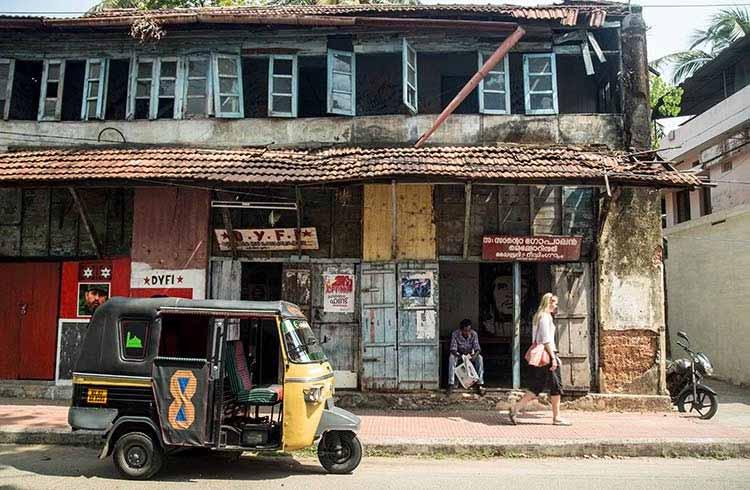
Sample destinations: Sample destinations: China, Italy, Turkey, Paris
10) THE NOT-SO-HELPFUL STRANGER
The scam: The scam: The scam: The scam: The scam: A stranger approaches a couple or family and volunteers to snap a group photo. You hand over your camera or smartphone, and the stranger runs off with it . A local asks if you need help with the ATM and palms your bank card or pickpockets you while you are responding.
How to avoid it: How avoid it: How to avoid it: How avoid it: How to avoid it: Never trust a stranger with your camera or phone. Use a selfie stick if you must. Ask friends or family members to stand guard while you are using an ATM and don’t let anyone approach while you are in the middle of a transaction.
Sample destinations: Sample Sample destinations: Sample Paris, Rome, Budapest, Prague, Johannesburg, Philippines, Nicaragua
(By Andrea Sachs for The WashingtonPost)
SEASONAL MAGAZINE
TO HELP YOU SPOT THE HOAXES, WE ASSEMBLED 10 OF THE MOST COMMON PLOYS AROUND THE WORLD AND OFFER TIPS ON HOW TO PROTECT YOURSELF FROM THEM.



SEASONAL MAGAZINE REALTY
PRESTIGE GROUP HAS ACHIEVED A ROBUST OVERALL PERFORMANCE IN THE JUST CONCLUDED Q1. THE LEADING BENGALURU HEADQUARTERED DEVELOPER HAS REGISTERED SALES OF RS. 39,147 MILLION, WHICH IS UP BY 30% YOY. PRESTIGE ACHIEVED THIS BY SELLING 2276 UNITS IN Q1 FY24, WHICH SPANNED OVER 3.83 MILLION SQ FT. THIS IS A REMARKABLE ACHIEVEMENT AS IT TRANSLATES TO 25 PREMIUM APARTMENTS OR VILLAS BEING SOLD EACH DAY OF THE QUARTER. MAJOR NEW LAUNCHES ARE NOW LINED UP FOR MUMBAI, BENGALURU, CHENNAI AND HYDERABAD, WHILE KOCHI WILL WITNESS THE OPENING OF A NEW FORUM MALL.

SEASONAL MAGAZINE
While quarterly sales was also up sequentially, the listed realtor recorded collections of Rs. 27,408, which was equally robust, being up by 28% yoy during this June quarter. Average realisation per sq ft has also soared to Rs. 10,244, which is up by 20% yoy for Apartments and Villas, showing the strong brand preference for Prestige in all its core markets.
On the commercial front, sales was up by 32% yoy. Plot sales by Prestige has recorded a realisation of Rs. 5007/ sq ft. One new residential project, Prestige Lavender Fields, was launched by the developer which has a potential developable area of 3.12 million sq ft. It was a runaway hit with 85% of the project getting sold during the launch period which also contributed over Rs 2,000 core of sales in Q1.

Completions of earlier launched projects were also at a brisk pace with total completions during the quarter achieving 5.90 million sq ft across four projects. These completed projects are three residential projects in Bengaluru - Great Acres@The Prestige City, Prestige Marigold & Prestige Elysian - and a hospitality project - Mulberry Shades Nandi Hills Tribute Portfolio.
This is a 102 keys hospitality project right in the foothills of Nandi Hills, one of Bengaluru’s renowned hill stations, around 60 km from Bengaluru. The ongoing Q2 of this fiscal will also witness the opening of a niche project, this time in retail, when Forum Thomsun mall gets inaugurated in Kochi. This is a 1.02 million sq ft
commercial space that will further strengthen Prestige’s Forum retail franchise in Kerala.
During the release of the Q1 update, Irfan Razack, Chairman and Managing Director of Prestige Group said, “We are pleased to announce a steady performance in the first quarter in line with our annual guidance. This achievement reflects our firm commitment to delivering exceptional value and quality to our customers. The consistent growth in sales is a testament to our strong market presence, robust operational capabilities and the dedication of our team. It reinforces our confidence in achieving our annual targets and sets a solid foundation for the remainder of the year.”
Prestige is now gearing up for some significant launches in the ongoing and upcoming quarters that are designed to propel their growth so that they are able to achieve or even surpass the targets that they have set.
Commenting on the highlights of the Q1 performance, Venkat K Narayana, Chief Executive Officer, Prestige Group said, “We are happy to report strong operational numbers in the first quarter, with sales close to Rs 4,000 crore and collections close to Rs 2,800 crore. Also, Mumbai region continues its strong contribution, clocking around Rs 600 crores of sales this quarter.”
Indeed, Mumbai is all set to witness two major launches in the coming months.They are Prestige Ocean with a total developable
area of 1.68 million sq ft, and Prestige Nautilus with a TDA of 0.9 million sq ft.
Other upcoming launches by Prestige include Prestige Park Grove with a TDA 9.23 million sq ft and Prestige Serenity Shores with a TDA of 1.5 million sq ft, both at Bengaluru; and The Prestige City at Hyderabad (12.6 million sq ft), Prestige Pallava Gardens at Chennai (4.56 million sq ft). These strategically designed projects are designed to contribute significantly to Prestige’s sales and strength in all their key markets.
What sets apart a leader in any sector is how it performs during downturns rather than in good times. The first three quarters of this fiscal delivered serious headwinds for the entire real estate sector, as it witnessed unprecedented rate hikes by Reserve Bank of India (RBI) in its bid to contain the inflation contagion that hit Indian shores too due to the Russian invasion of Ukraine. But a sector leader like Prestige Estates Projects faced these headwinds with considerable strength, which is readily seen from its H1 (Q1+Q2) results as well as the ongoing sales momentum in Q3 & Q4. The Bengaluru headquartered developer which had guided for Rs. 12,000 crore of pre-sales for this current fiscal, could surpass more than halfway of this - Rs. 6500 crore - by the end of H1 itself. The listed developer has done extremely well in both its residential and office / commercial segments. This helped the developer report an 80% surge
SEASONAL MAGAZINE
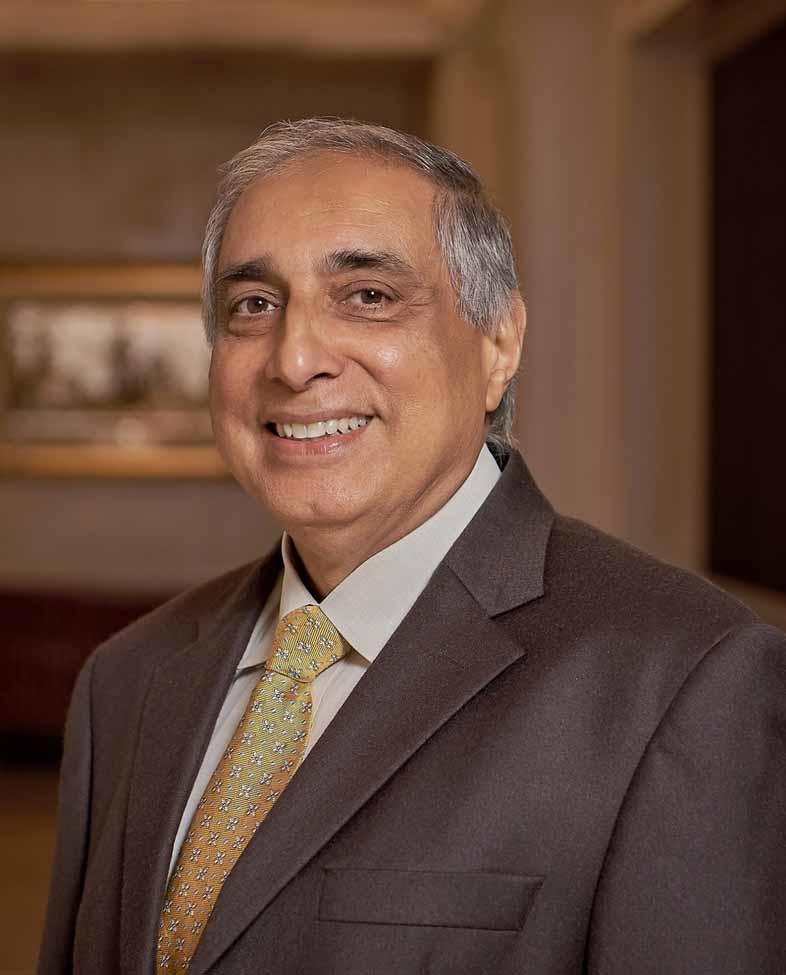
SEASONAL MAGAZINE
Irfan Razack Chairman & Managing Director
in its consolidated net profit at Rs 140.7 crore in Q2 of this fiscal year, on a yearon-year basis. Total income rose to Rs 1,474.7 crore in the second quarter of this fiscal year from Rs 1,345.2 crore in the corresponding period of the previous year. Sales bookings during Q2 rose 66% yearon-year to Rs 3,511 crore on higher demand despite a rise in home loan interest rates. For the full half year of this fiscal or H1, Prestige Estates’ sales bookings more than doubled to Rs 6,523.1 crore from Rs 2,845.9 crore in the corresponding period of the previous year. The developer sold 3,210 units during the second quarter, translating to 36 Prestige homes sold every day on an average basis. Total sales during H1 was 8.18 million square feet with an average realization of Rs 7,976 per square feet. In its core and traditional market of Bengaluru, its pre-sales was largely led by the sprawling Prestige City project so far, and going forward, Prestige has a pipeline of 25 million sq ft of upcoming launches to keep the residential momentum in high gear, of which around half is from nonBengaluru markets like Mumbai, NCRDelhi, Hyderabad, Chennai, Pune and smaller markets like Kochi and Calicut. It also has Rs 6,500 crore of inventory in ongoing projects to rely upon in Q4 and beyond. Earlier, in FY’22, Prestige had reported sales bookings of Rs 10,400 crore, thereby becoming the first real estate company to breach Rs 10,000 crore presales mark in the country. Despite its entry into the Mumbai market only a couple of years back, Prestige was among the top sellers in the central suburb of Mulund with sales worth Rs 883 crore in 2022. Prestige
Estate’s commercial portfolio is also doing extremely well, and it is most bullish on Mumbai from where it expects around 50% of its overall rentals to come from by the next few years. Prestige has three office towers, spread over 10 million square feet coming up in the core Mumbai business district of Bandra Kurla Complex, as well as upcoming office towers in Pune, Hyderabad, and Kochi too. But the bigger story from Prestige is that the company has performed well during the recent headwinds, and that these headwinds are now all set to subside with inflation easing and rate hikes getting paused or even reversed soon. This will deliver significant tailwinds for the company in Q4 and beyond.
FY’22 had gone down in India’s real estate sector, with a unique change in the pecking order. Noted Bengaluru headquartered developer, Prestige Estates Projects had zoomed past sector leaders DLF, Macrotech (Lodha) & Godrej Properties by way of

sales booking in the last quarter of FY ’22. If anyone thought it was a one-off or anomaly, Prestige has proved that they are wrong, in Q1 of this fiscal. Despite the significant headwinds by way of the 140 bps interest rate hikes, and unprecedented cost escalations, Prestige has shown significant momentum with Q1 sales booking jumping 310% on a year-on-year basis to over Rs 3000 crore. The overall momentum was striking as it translated to Prestige selling almost 28 homes every day of Q1, with a total of 3.63 million sq ft spanning 2560 units at an average pricing of Rs. 8500 per sq ft. Prestige seems to have clearly benefited from the market’s consolidation to the more organized and credible players post RERA implementation in the country. For Chairman & Managing Director, Irfan Razack, the emergence of Prestige into national leadership and international limelight is a matter of vision fulfilled as he has always guided the listed developer to be highest in quality and ambition, but lowest in noise. A bigger story in Prestige Estates Projects is that it is targeting to sell properties worth at least Rs 12,000 crore this fiscal, up 16% annually, with 8,500 crore coming from its core market of Bengaluru and the rest from other cities such as Mumbai and Hyderabad. Already, around Rs 750 crore of sales bookings in Q1 had come in from its new market of Mumbai. To achieve such high growth Prestige has plans to launch multiple projects, having close to about 15 million square feet of area, in the upcoming quarters of this fiscal year, apart from selling its inventories in the ongoing projects. Close on heels of its success in Mumbai, Prestige is also planning to launch a project in the Noida market this fiscal.

SEASONAL MAGAZINE
When it comes to capital markets, there is nothing like being a leader. From TCS to Asian Paints and from Reliance to HDFC Bank, it is a winner-takes-it-all market. Eyes of the foreign and domestic institutional investors, who basically drive the Indian equity market, are forever focused on the longstanding sector leaders, and on emerging leaders if any. That is why Prestige Estates Projects is in international limelight right now, after their FY’22 numbers were published. For, in this past fiscal, Prestige has stunned most industry watchers to emerge as the largest developer in India in terms of sales booking, ahead of traditional sector leaders including DLF, Macrotech (Lodha) & Godrej Properties. If you are stock savvy, you will now be eager to know the market cap of Prestige vis-a-vis these peers, and the answer is it is way too lowonly 46% of Godrej, 34% of Macrotech and 22% of DLF. Yes, by now, you will be able to guess where Prestige is headed, and that is only one reason why Prestige Estates is in international limelight right now!
When the Q4 and annual numbers of India’s top four listed developers came in, there were many interesting trends to detect. For one, all were in serious sales upswings. But Prestige squarely beat all the other three - DLF, Lodha & Godrej - in absolute sales bookings during the past fiscal, and also on percentage terms, except for DLF.
Against Lodha’s sales bookings of Rs. 9024 crore, DLF’s Rs. 7273 crore, and Godrej’s Rs. 7861 crore, Prestige recorded a sales booking of Rs. 10,382 crore, beating them all by a wide margin. Needless to say, it is Prestige’s largest sales booking ever too. In percentage terms, while Lodha witnessed a 51% growth in sales bookings and Godrej saw a 17% growth, Prestige grew by 90%, second only to DLF’s 135% growth which was however from a low base last year. There was more to this performance by Prestige than which meets the eye. Firstly, all the other three developers were headquartered in either Mumbai or in DelhiNCR, and their primary development activities concentrated in these two regions, which are the most expensive two realty markets in India. In contrast, Prestige is headquartered in Bengaluru, with its primary developments there, and has only recently entered Mumbai and NCR-Delhi, which means its highest-value sales are yet
to kick in, on a massive scale!
And when it comes to market capitalization, Prestige is much smaller than these three peers that it decisively overtook in sales bookings! And when you go into the internals of this market-cap riddle, you realize that it is indeed a matter of lower valuation, with Prestige’s Trailing Twelve Months (TTM) Price/Earnings (P/E) multiple being at just 15 times, as against 53 times accorded to DLF, 46 times to Lodha and 105 times given to Godrej! Now, with Prestige emerging as the sales leader, expect a big shakeout in the realty sector valuations!
No wonder then that international heavyweights like Morgan Stanley and JP Morgan are both having ‘Overweight’ stance on the Prestige stock with targets of Rs. 612 and Rs. 635 respectively as against the scrip’s price of around Rs. 425 now.
One reason why Prestige has been able to do quite well in FY’22 is its unwavering focus so far on the Bengaluru market. The Silicon Valley of India performed quite well in Q4 of FY’22, both in terms of housing sales and new launches. As per ANAROCK Research, Bengaluru saw housing sales of nearly 13,450 units in this quarter, which is an yearly growth of over 55%, while new launches stood at
13,210 units, an increase of 72%.
As the de facto leader of Bengaluru, Prestige reaped rich dividends from this post pandemic trend. There was robust demand for its sprawling Prestige City project in Bengaluru as well as for its new launches in Hyderabad and elsewhere in the country. But the future game changer for Prestige is expected to be its recent foray into India’s economic capital of Mumbai, and arguably the country’s most expensive realty market. Prestige had launched its first residential projects in Mumbai Metropolitan Region (MMR), including Prestige City at Mulund, Prestige Daffodils at Pali Hill, and Prestige Jasdan Classic at Central Mumbai. The response to these three projects at the launch event itself has been extremely good, attesting to the well-thought of nature of these offerings. Prestige has a stated aim of achieving Rs. 3,000 crore in annual sales from these and upcoming MMR projects.

Total launches by Prestige in FY22 stood at 16.77 million square feet. For this ongoing financial year, the company has set a sales guidance of more than Rs. 10,000 crore, which it expects to achieve through a strong pipeline of projects in Bengaluru and other markets like Mumbai. Going forward, more
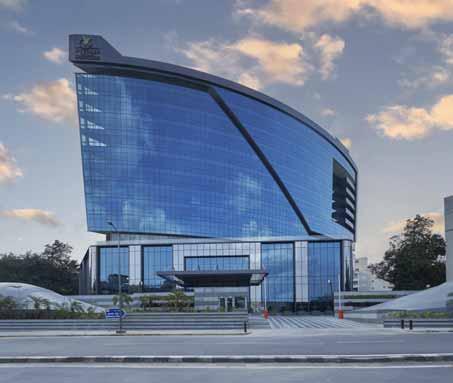
SEASONAL MAGAZINE
than 50% of the new launches are slated outside of its core Bengaluru market.
Prestige has long been pursuing a goal of debt reduction, and it has a stated objective of maintaining net debt/equity ratio at around 0.5x in the medium term. In Q4 of FY’22, the success of this plan was visible with its net debt to equity ratio standing at 0.35x. Net debt fell sequentially or QoQ from Rs. 4,170 crore in Q3 of FY’22 to Rs. 3,360 crore in Q4 of FY’22. The company has achieved this through some extraordinary and wellstructured deals during the last two years.
In 2021, Prestige had announced the sale of some of its commercial and residential assets in two phases to the US based Blackstone Group, for reducing its debt. The deal had a total enterprise value of around Rs. 9,160 crore. The second phase of the Blackstone deal has also concluded in FY’22, with the remaining payment of Rs. 250 crore to Prestige expected soon.
During the last three years, Prestige has been witnessing a dramatic period of turnaround. Under Chairman & Managing Director Irfan Razack’s visionary leadership, FY’21 saw Prestige’s profits and RoE nearly tripling, and debt-to-equity diving to onethird of the previous year thanks to the $1.5 billion Blackstone deal.
Unlike many of its southern peers, Prestige has a significant portfolio under lease. Prestige has 29 million sq ft of office space and 5 million sq ft of retail space in various stages of implementation now. The residential sales and commercial leasing activity act as twin engines of growth for Prestige, and are complementary in nature. While sales momentum in the residential segment generates free cash, timely
execution in the leasing segment contributes to the further value generation.
Prestige also enjoys significant pricing power in the market, and this has come in handy during this inflationary period that has driven up input and construction costs. To offset this, Prestige has raised prices recently.
But what really matters for Prestige now is the impressive diversifications it is undertaking in warehousing, hospitality, retail and its impressive geographic diversification into Mumbai.
One huge advantage a brand like Prestige Estates holds in India’s realty market is that, having made a name for itself in high quality residential and commercial projects, it can extend that expertise and goodwill to new buzzing segments as they emerge. The firm had some time back made such a silent foray into large Grade A warehouses. For testing the waters, it built two such warehouses in a 15 acre land it held in Malur near Bengaluru.
As in every Prestige project, keen attention went into every detail, especially as it was a learning experience for the company too, as it was doing Grade A warehouses for the first time. But it came out with flying colours with one of the buildings attracting e-com major Flipkart as the tenant and the other being taken by Dhoot Transmission.
Now, having proved itself in this domain with such a pilot project, Prestige Estates is going all out to develop this domain, especially as there is a huge demand from e-commerce companies like Flipkart, Amazon, and several of their smaller peers. Towards this, the company has acquired

multiple land parcels in and around Bengaluru as a first step.
Being a Bengaluru headquartered developer, the company has unparalleled expertise in the city, and the city being the e-commerce hub of India also augurs well for it. Later on, Prestige plans to take this vertical to other regions of the country too. But unlike some of its peers, it is not making a big splash for attracting investors at this stage, despite the warehousing sector attracting $900 million investments in 2021 alone.
Like in everything it does, Prestige wants to differentiate itself in this sector with premium offerings, and it also wants to undertake significant growth and value addition in this vertical, before considering to on-board investors into this. This has been a strategy it did quite successfully in its retail & office space vertical, as seen in the Blackstone deal.
In Grade A warehousing, it is eyeing a unique opportunity, as large organized players like itself with expertise in everything from conceptualization to land acquisition to design to execution to leasing, is rare in this field. That is why Prestige is confident of differentiating its upcoming warehouses from the rest of the pack. By investing significant funds into this vertical on its own, Prestige wants to build one of the largest Grade A warehousing portfolios in the country.
With its foray into warehousing, Prestige is also closing a gap in its portfolio in retail. Already, it was a noted player in brick n’ mortar retailing, having developed several malls and running them too. Even though it sold off significant retail properties to Blackstone, it remains bullish on physical retailing as it believes that going forward retailing will follow a hybrid model of ecom and brick n’ mortar.
This can be seen from the changing strategies of e-com companies like Flipkart, Amazon, Jiomart etc, all of whom are planning to leverage the tens of thousands of multi-brand and singlebrand physical stores owned by individual retailers in malls and high streets for wider reach and rapid delivery to their growing customer base. This means significantly more business for such shops and malls, and Prestige is gearing up for this future with two new malls under construction and six more
SEASONAL MAGAZINE
malls in the planning stage. When these are complete, Prestige will have double the retail properties compared to the retail assets it sold to Blackstone last year.
With large IT and ITES players starting to bring back their huge workforces back to their offices, Prestige is also eyeing an uptick in the demand for office space. Sensing the green shoots of recovery in office space demand, it is building several such office space projects in multiple cities including India’s economic capital of Mumbai.
Another segment that is witnessing a renewed surge post the pandemic is revenge travel, among both business and leisure travellers, and hospitality properties stand to gain the best benefits out of this. Prestige, which already has a strong foothold in hospitality, is all set to cement it further by a major tie-up with US hospitality major Marriott International for two new hospitality projects in New Delhi. Prestige and its 50:50 joint venture partner DB Realty will develop two Marriott hotels and a convention centre in a 7.7 acre land in Aerocity.
The two projects - New Delhi Marriott Marquis & Convention Centre and The St. Regis Aerocity – are unique in the Indian market. While the former will be the first Marriott Marquis & Convention Centre in India, the latter will be a tribute to Marriot’s flagship hotel in US, The St. Regis New York, and will feature its renowned New York Deli. Together these two properties will bring 779 rooms to the New Delhi hospitality market, and 85,000 sq ft of premium meeting spaces. For the convenience of business and leisure travellers visiting and staying in New Delhi, the two properties are coming up quite near to Indira Gandhi International Airport.
And it is not only expansion into such buzzing verticals that Prestige is handling currently. It is in the midst of doing what is historically its greatest expansion ever – a geographic expansion – into Mumbai, arguably the hottest property market in the country for long.
Traditionally, most non Mumbai based developers have however not fared well in the city which is home to stock market titans and Bollywood celebrities, due to multiple reasons. One factor has been the exorbitant cost of land, which has resulted in either super expensive apartments that few developers can market effectively, or the
super small apartments for the masses which witness intense competition between almost all kinds of developers. Into such a scenario has Prestige entered boldly with some unique projects.

Prestige’s very first project in Mumbai, Jasdan Classic in Central Mumbai speaks volumes about their strategy for the city. Even when some of the largest Mumbai based developers prefer far away suburbs for premium projects, Prestige has chosen an inside city land at Byculla West for this flagship project. Jasdan Classic consists of two skyscrapers with 233 ultra luxury homes. They are relatively large sized apartments with configurations of 2,3,4BHK and priced between Rs. 3.69 crore and Rs. 9.44 crore.
Jasdan Classic is spread over 2.2 acres of land, with each tower of 45 storeys. Nine levels of podium parking, three levels of clubhouse and plush amenities like an infinity swimming pool, gym, spa, squash court, & multi-purpose hall are available inside the sprawling project.
All the apartments here are designed in spacious layouts with ultra-modern living areas, large windows for cross ventilation and balconies featuring breath-taking views of the South Mumbai cityscape. The Arabian Sea on the West and the Eastern Harbor on the East sets the perfect tone of style and class for the prospective homebuyers here.
The message from Prestige is loud and clear – they are not compromising on location, or space offered or on ultra-premium amenities. While marketing such a project is a tough call for many developers, Prestige
is confident of handling it comfortably, and besides that, since there are only 233 homes to sell, this flagship project from Prestige is likely to be a sure and steady sell-out.
The selection of a hot and expensive location like Byculla West in Central Mumbai for their flagship project, is not a one off strategy either. Upcoming residential projects from Prestige in Mumbai would be at similar hot locations like Pali Hill at Bandra and Marine Lines. Prestige has boldly entered such super premium micromarkets, with a keen insight that for a change many high net worth families would prefer luxury homes in such prime locations rather than in the outskirts or suburbs of the city.
That is, if such projects were available. For long now, such homes from tier 1 branded developers were rare. In its upcoming commercial developments in Mumbai too, Prestige wants to develop in the best addresses, like it has always done in Bengaluru. This has led to it choosing land parcels in prime locations like Mahalaxmi and Bandra Kurla Complex for its first two commercial projects in the city.
However, this doesn’t mean that Prestige would be shying away from the other end of the housing spectrum in Mumbai, the relatively affordable segment. The listed developer has carefully chosen the buzzing suburb of Mulund for its foray into this segment. Interestingly, this is its largest land parcel so far in Mumbai, and given the intense competition there among most of the large players, expect Prestige to offer a significantly differentiated range of homes.
SEASONAL MAGAZINE
LAST SUMMER, MY HUSBAND AND I DROVE WITH OUR 4-YEAR-OLD AND 2-YEAR-OLD TO HIS HOMETOWN ON THE EAST COAST OF CANADA. WE WERE THERE TO BURY HIS PARENTS, A MEMORIAL THAT HAD BEEN A LONG TIME IN THE MAKING BECAUSE OF THE PANDEMIC. IT WAS A HEAVY, SOMETIMES MAGICAL TIME THAT, AFTER A FEW WEEKS, TOOK ITS TOLL.
n the four-day-long drive back home to Toronto, we pulled a U-Haul full of memories and keepsakes behind our aging Honda, praying nothing would fall off or out or something worse we hadn’t even considered. Our first stop along the way was a small town in Nova Scotia, where we pulled into a restaurant for lunch. We were all sticky from the hot car and tired, emotionally fried from the last three weeks, but the kids were faring surprisingly well.
It was one of those casual, pub-foodtype places, where nachos and fried foods littered every table and tinny Top 40 blared from the speakers above the bar. We sat down and ordered quickly, but between the lunch rush and understaffing, our chicken fingers and fries took over an hour to arrive. While we waited, the kids joked around with each other at the table, looked out the window next to our booth, danced in their seats to the music playing over the speaker, and generally entertained themselves during the excruciating
wait. Just as we were finishing up, an older couple who had been sitting behind us got up to leave. As they did, the wife got close to me and, in a tone anyone would recognize, told me my kids had ruined their lunch.

I admit: I lost it. I looked up at her, heat spreading across my face, and told her we’d just buried my husband’s parents and maybe she could show a bit of compassion. I regretted saying it immediately. What difference should his grief make to this stranger? And how dare I use it to try to win some


PARENTING SEASONAL MAGAZINE
hypothetical argument? The woman seemed unfazed. I apologized to my husband, and, thankfully, the kids seemed not to notice that this outburst had anything to do with them. We managed to laugh about it afterward, but that feeling, that itchy mixture of anger, guilt, shame, and resentment, sat like a heavy ball in my stomach the rest of the way home.
I’ve since thought about that interaction more than I want to admit. At any moment, like a shitty magic trick, I can conjure up those exact same emotions. Those maybe ten seconds impacted me, probably forever. And now, as school winds down for the year and parents prepare to scramble to entertain their brood for the next few months, that woman has been on my mind even more. Who has a right to exist, to take up space without judgment or reproach? And if it’s not our kids, some of our most vulnerable, then how can we call ourselves a loving society?
Whether it’s on an airplane, in a restaurant, in an elevator, or on the subway or any other space that throws strangers of all kinds into tight quarters, there’s an underlying tension that seems to fill the space when kids are involved. There’s an unspoken feeling that they should blend into the background, keep quiet, be still, and find a way to disappear in order to be accepted into a public space. But while you’re sighing or eye-rolling or just silently but obviously bracing yourself, trust that no one is more tense than the parents of these kids. We’re on edge, hoping desperately that they’ll be on good behavior, that they’ll be mindful of their words and actions, that they’ll find a way to be the best version of themselves and draw as little attention as possible to both them and us. Who has a right to exist, to take up space without judgment or reproach? And if it’s not our kids, some of our most vulnerable, then how can we call ourselves a loving society?
But they’re kids. Even at their most polite and small, they take up space. They cry, they laugh, they want to play, and they want to exist as they are. Are they wrong for that? If we can’t be hospitable to the young, who will we make accommodations for? Who do we give permission to be a part of the world? The list, seemingly, is ever-shrinking. Something seems to have shifted postlockdown, and our appetite for empathy and grace in communal spaces has withered. Our tolerance for the discomforts of the outside world, after an extended overabundance of inside comforts, is now paper-thin. I feel it acutely as a parent; in every public interaction and space, I’m holding my breath, watching the glares, and listening to the muttered grievances, every encounter underscoring that we shouldn’t be here, that we’re a nuisance and don’t belong. It’s a hostility that extends itself to anyone who is not an able-bodied adult; we design our spaces to welcome a select population and keep the rest at bay. Anyone who is vulnerable, disabled, or stands out knows immediately where they aren’t wanted, which spaces are welcoming and which aren’t.

Sure, of course there are oblivious parents, people who don’t respect the shared space and let their kids run wild without regard for others. But I promise you they’re a minority; most of us are
excruciatingly aware of how our kids are behaving and on tenterhooks making sure they don’t get in the way. I try desperately to make sure my kids are mindful of where they’re walking, of who else they’re sharing space with, and when they need to make room for someone else. More than anything, I want them to be caring, respectful people who can extend grace where they see fit. But they’re still kids. They’re loud, they get in the way, they exist. This summer, when you see kids and families at the airport or on a patio, make some allowances for their personhood, just as you’d expect others to make room for yours. We all carry our own personal grief, trauma, sorrow, and fear, so what if we tried harder to be compassionate and understanding of what’s unspoken in our shared spaces? How much easier would it be to navigate the world?
I’ve thought so often about what I wish I’d said instead to that woman who refused to let that moment go by with some sympathy. I know she probably won’t see this, but there are many, many others just like her, and hopefully some of them will. Meanwhile, I’ll be traveling and taking my kids to restaurants and galleries and teaching them how to be in the world with the kind of empathy and love we all deserve.
(Credit: Amil Niazi for The Cut)
SEASONAL MAGAZINE
LOUIS VUITTON’S NEW CREATIVE DIRECTOR, PHARRELL WILLIAMS, PAYS TRIBUTE TO HIS PREDECESSOR WITH HIS DEBUT COLLECTION

The debut collection by Pharrell Williams, creative director of menswear for Louis Vuitton, was the most eagerly anticipated show of the 2024 menswear season. Excitement and expectations for the collection have been high ever since the musician and producer was named to the position. For the Spring Summer 2024 menswear show, celebrities from all around the world descended on the Pont Neuf, one of the oldest bridges in Paris.
THE ACTRESS WILL REPRESENT THE BRAND IN SOUTH KOREA.

Expanding its footprint in the global market, Ginori 1735 recently opened a new store in South Korea in association with actress and model Ko So-young. As a natural extension of this connection and their position in the luxury market of Asia, the Italian porcelain house has appointed the Korean actress as its brand ambassador. The new brand ambassador will help increase Ginori 1735’s awareness and will promote its business. Ginori 1735’s store in Seoul merchandises all of its best-selling collections, which will appeal to South Korean patrons.
KROSS STUDIO INAUGURATES A NEW ERA OF HOROLOGY WITH THE FIRST EVER CENTRAL FLOATING TOURBILLON

With the new mechanically sophisticated and trailblazing KS 05 timepiece collection, Kross Studio unveils brave technology and refined designs. The creative and ingenious masters of watchmaking, Kross Studios, has pulled out all the stops with its very first completely in-house central flying tourbillon. While the brand’s collaborations with well-known entertainment brands has produced marvelous timepieces that blur the line between mechanics and creativity, this time it single handedly produced a technical timepiece, and in doing so, created the world’s first central floating tourbillon with a novel brave movement and stylish design aesthetics.
BOLD & BEAUTIFUL, HAZOORILAL’S ZOORI COLLECTION IS THE ULTIMATE form of self-expression
Zoori, the latest jewelry line by Hazoorilal Legacy, reflects the rising desire of creators and designers for an imaginative, distinctive design, crafted with the highest level. This collection is a unique and fun move deep into the realm of fine jewelry. Each piece is aesthetically pleasing and is made to complement your unique style. Captivating colors and striking designs are at the heart of these evocative jewels.
GUCCI’S NEW HIGH JEWELRY COLLECTION, ALLEGORIA, MIMICS THE SHADES OF SEASONS

With its Gucci Allegoria, the Italian brand wants the world to explore the nature’s ability to transform through seasons and its grandeur, which is as enticing as its grand gems. The pristine beauty of seasons yet again finds its way in another jewelry collection, but this time, rather than fixating on a particular season, the assemblage showcases the charm of the passing of seasons, and since its Gucci, the designs are heavily instilled with unique combinations, daring cuts and sparkling stones.

SEASONAL MAGAZINE
QUIRKY & EYE-ARRESTING, SOTHEBY’S WILL PRESENT 22 EXCLUSIVE LOUIS VUITTON ARTYCAPUCINES BAGS

These vibrant Capucines bags will be on display at Sotheby’s Paris from July 1 to 5. In collaboration with Louis Vuitton, auction house Sotheby’s will auction off 22 classic artist-designed Louis Vuitton Artycapucines bags. Each of these Capucines bags was recreated using LV’s exacting savoir-faire and the 22 participating artists' signature style. All the pieces in this splendid lineup are signed by the artist and given in a monogrammed Louis Vuitton Boîte Chapeau, which is a contemporary take on a vintage LV hat box created in 1924, each personalized by the 22 participating artists.
BOVET’S NEW LIMITED EDITION WATCH CELEBRATES THE OPENING OF THE PRESTIGIOUS OWO RESIDENCES IN LONDON

Swiss watchmaker Bovet will create ten special editions for the owners of the most opulent residences, situated at London’s Old War Office. The OWO Residences by Raffles has joined forces with the Swiss watchmakers Bovet and announced an exclusive collaboration to produce a special edition of 10 classic timepieces. Former Winston Churchill's wartime headquarters in London, once known as the Old War Office, has been exquisitely revamped into Raffles's first hotel with private residences.
BEHOLD THE NOVEL HM8 MARK 2 BY MB&F
Astute and agile, the watch looks like it's ripped straight from a supercar. Watchmaker MB&F has been ubiquitous in the watch industry for a long time, beginning with the HM5 in 2012, the HMX in 2015, and the HM8 in 2016. All sprang from MB&F founder Maximilian Büsser's longforgotten desire of becoming a car designer. His aspirations were rekindled as he continued to realize them into exquisitely designed automotive-inspired timepieces. The HM8, specifically, was inspired by the Can-Am cars from the famous Canadian American Racing Championship. The watch had a sapphire crystal cover that also allowed a view on the spinning rotor.

PAUL SMITH’S SPRING SUMMER ‘24 COLLECTION IS MASCULINE AND MASTERFUL
The collection showcases the beauty and power of tailoring, a fusion of subtle colors and sublime patterns. Paul Smith’s latest Spring/ Summer 24 collection is all about tailoring. Titled “The Suit (But Different)”, the collection has managed to turn heads at the Paris Fashion Week.

EXPERIENCE ASTON MARTIN’S UNRIVALED BRITISH BESPOKE SERVICES AT THEIR FIRST FLAGSHIP, Q NEW YORK.
British sports car manufacturer Aston Martin officially opened their first flagship design center in New York, occupying a prominent space on 450 Park Avenue. Called Q New York, the flagship will offer car aficionados and clients a unique chance to custom tailor any Aston Martin of their own choice.

KERING BEAUTÉ ACQUIRES FRAGRANCE HOUSE CREED


This latest move is intended at expanding Kering’s beauty business. In an effort to strengthen their stance in the beauty sector, Kering Beauté has bought the upscale fragrance house Creed. This year, in February, Kering launched its own beauty division and appointed Raffaella Cornaggia as the Chief Executive Officer of Kering Beauté. As the first acquisition of Kering Beauté, Creed provides Kering Beauté with

SEASONAL MAGAZINE
EX-U'KHAND CM SITS ON CHAIR ON A WATERLOGGED ROAD IN PROTEST
Former Uttarakhand CM Harish Rawat protested against waterlogging in the state by sitting on a chair in Haridwar on a waterlogged road, a video of which surfaced online. "People are living in difficult situations. All they (state government) had to do was drain out the water using three-four pumps, it's not rocket science," he said.

JAPANESE WOMAN HELD FOR MAKING 2,761 FALSE EMERGENCY CALLS, SAYS 'I WAS LONELY'

A 51-year-old woman has been arrested in Japan for allegedly making 2,761 false emergency calls over a period of nearly three years. "I was lonely and wanted someone to listen to me and give me attention," the suspect reportedly said. She repeatedly made calls complaining of stomach ache, drug overdose and aching legs, among other symptoms.
INDIA GIFTS 34 AMBULANCES, 50 SCHOOL BUSES TO NEPAL

India on Sunday gifted 34 ambulances and 50 school buses to Nepal, the Indian Embassy in Nepal said. "Gifting of the vehicles has been one of the long-standing traditions of the government of India under the Nepal-India Development Partnership Programme," said Indian Ambassador Naveen Srivastava, who handed over keys of the vehicles to various Nepali organisations.
TESLA IS FOR THE WEST, SAYS OLA'S BHAVISH AS TESLA HOLDS TALKS FOR INDIA FACTORY
Amid reports of Tesla holding talks to set up its first factory in India, Ola Co-founder and CEO Bhavish Aggarwal said, "Tesla is for the West, Ola is for the rest." Aggarwal said, "Ola Electric has grown and matured faster than I'd initially planned." The Elon Musk-led company is reportedly in discussions with the Indian government for an investment proposal.

MASSIVE PROTESTS IN ISRAEL OVER JUDICIAL OVERHAUL, VIDEO SURFACES

Thousands of Israelis on Saturday protested against PM Benjamin Netanyahu-led government's plan to overhaul the judiciary. Israel's ex-Minister for Social Equality and Pensioners Meirav Cohen shared a video on Twitter, showing thousands of people protesting against the judicial overhaul. Recently, Israel Parliament gave initial approval to a bill to limit the Supreme Court's oversight powers.
AI IS LIKE IPHONE PLATFORM BUT 100 TIMES LARGER: OPENAI INVESTOR

Billionaire venture capitalist Vinod Khosla, who is an investor in OpenAI, likened artificial intelligence (AI) to the launch of the iPhone platform. When the iPhone system was launched, it enabled different apps like Uber and Airbnb to come into existence, Khosla said. AI is the same kind of platform but 10 or 100 times larger, he added.
WE MUST PREVENT BUREAUCRATISATION OF FINANCIAL SERVICES: KOTAK
Kotak Mahindra Bank CEO Uday Kotak said India "must prevent bureaucratisation of financial services" and let "entrepreneurship thrive". "The financial sector players risk becoming more robotic...since the fear of making a mistake overrides the joy of creation," he stated. "We must avoid the mindset that we want accident-free roads hence we will restrict cars," he added.

SEASONAL MAGAZINE































































































 SEASONAL MAGAZINE
SEASONAL MAGAZINE
























 KT RAMA RAO
KT RAMA RAO






 SEASONAL MAGAZINE
SEASONAL MAGAZINE










 MVJ Medical College, Hoskote
Al-Azhar College in Thodupuzha
Amal Jyothi Engineering College
Lovely Professional University SEASONAL MAGAZINE
MVJ Medical College, Hoskote
Al-Azhar College in Thodupuzha
Amal Jyothi Engineering College
Lovely Professional University SEASONAL MAGAZINE



 Swami Vivekananda College, Pune
Indian Institute of Tourism and Travel Management (IITTM), Gwalior
Kakatiya Medical College
IIT Mumbai
Swami Vivekananda College, Pune
Indian Institute of Tourism and Travel Management (IITTM), Gwalior
Kakatiya Medical College
IIT Mumbai








































